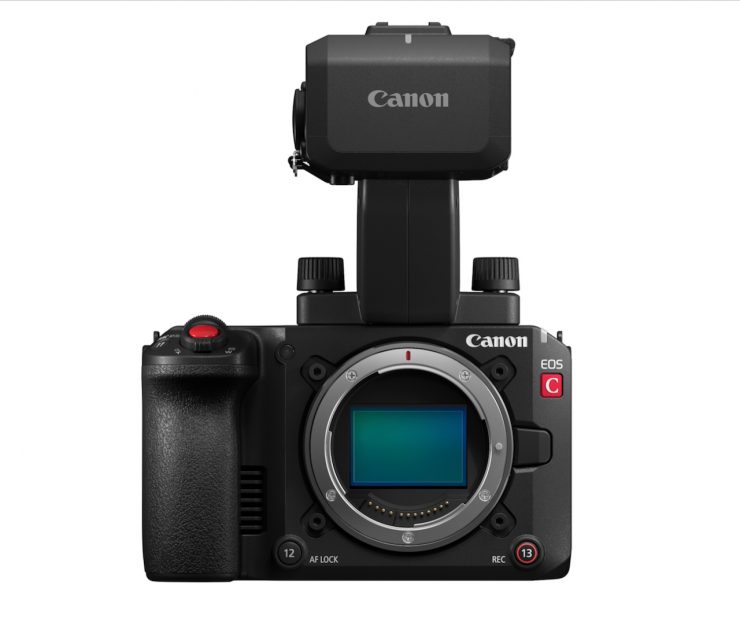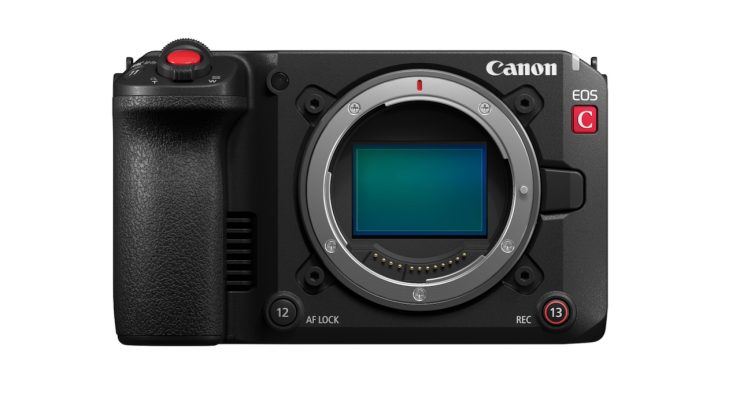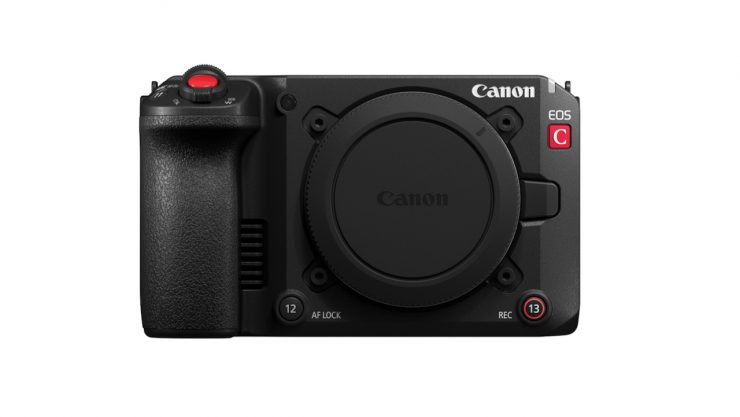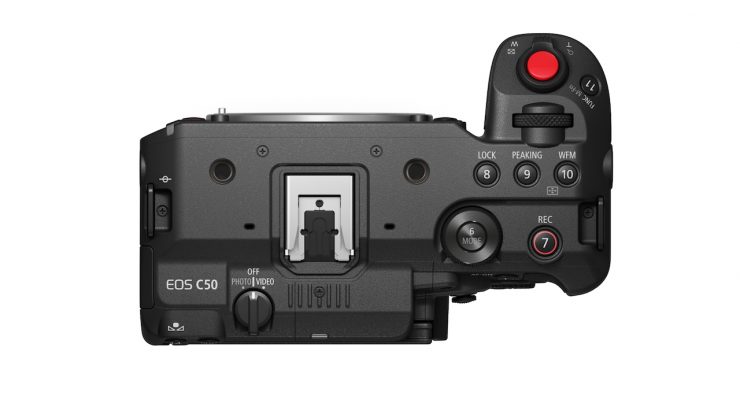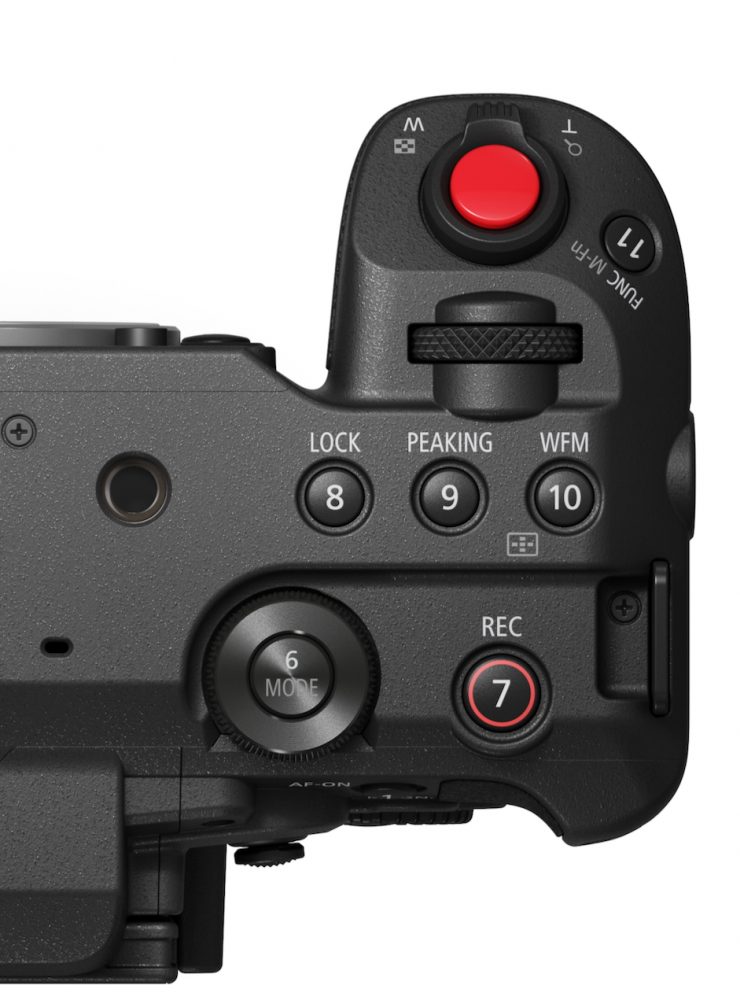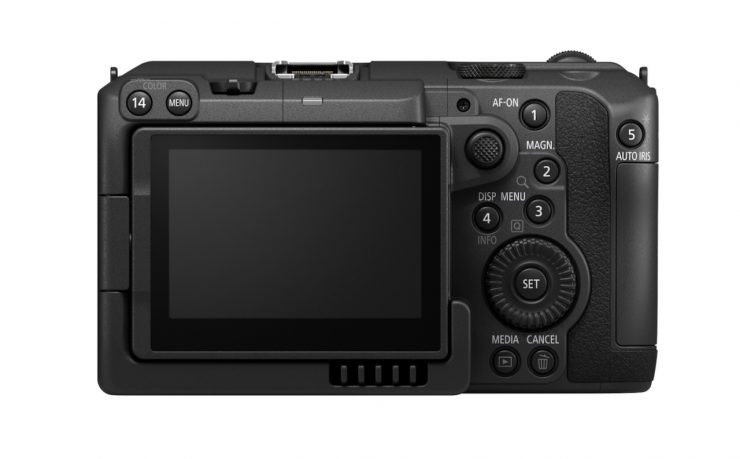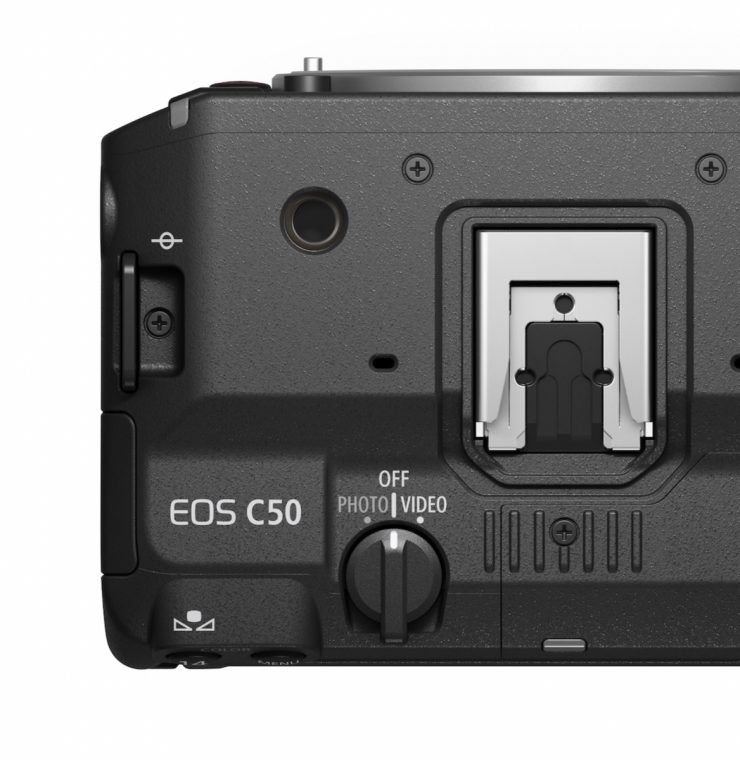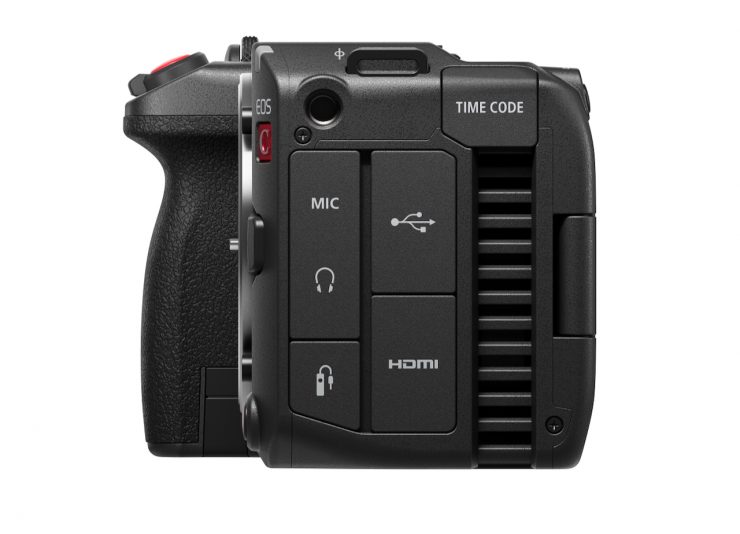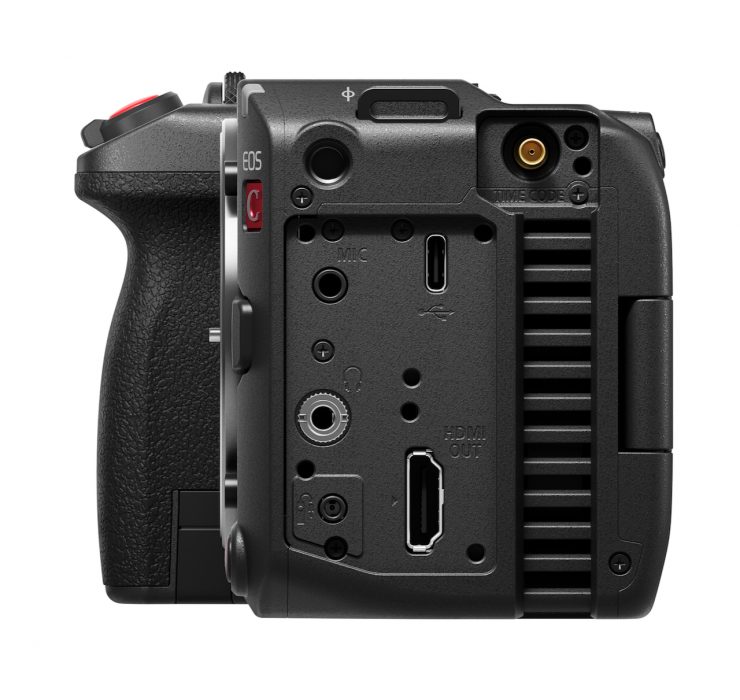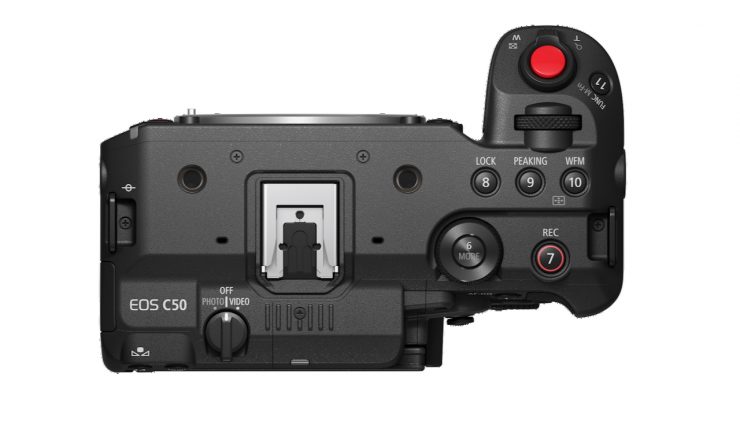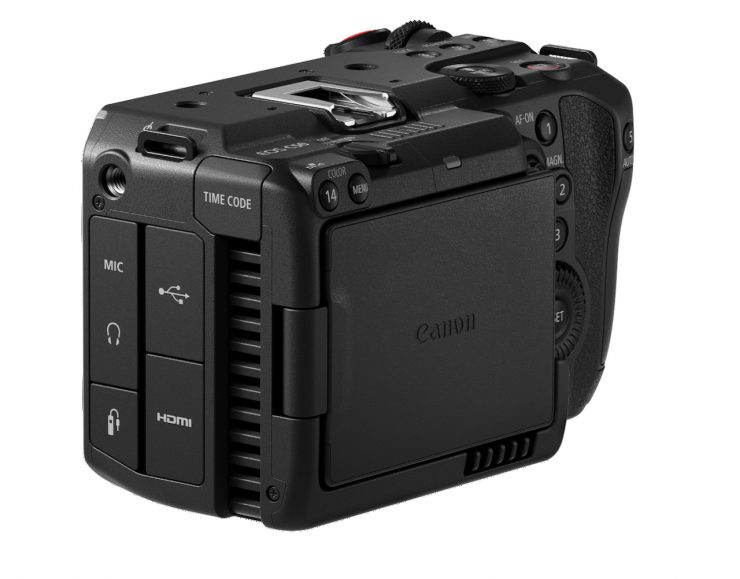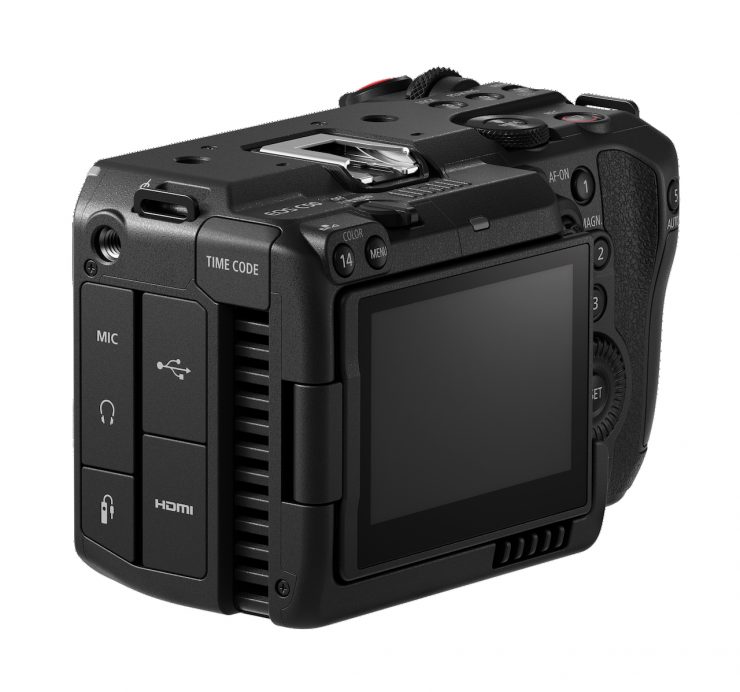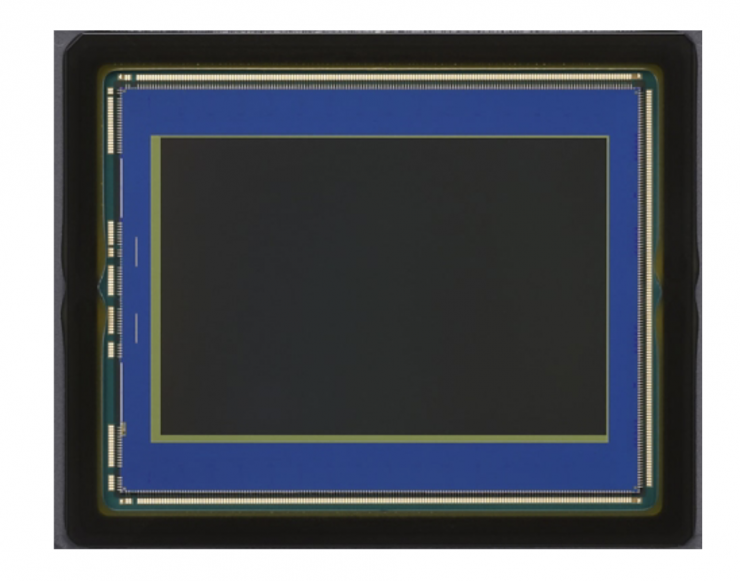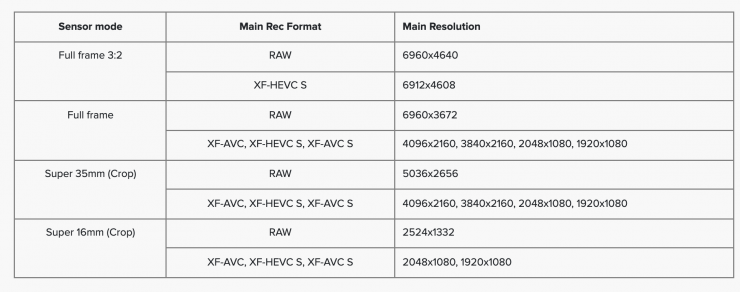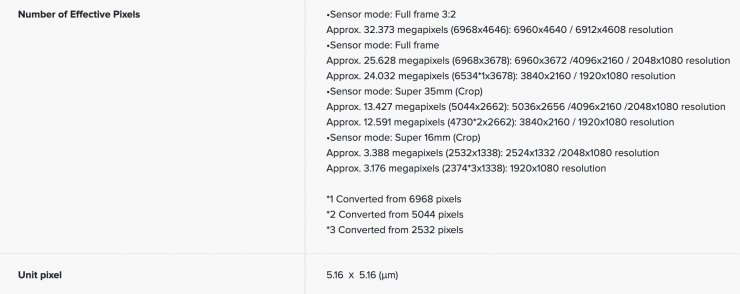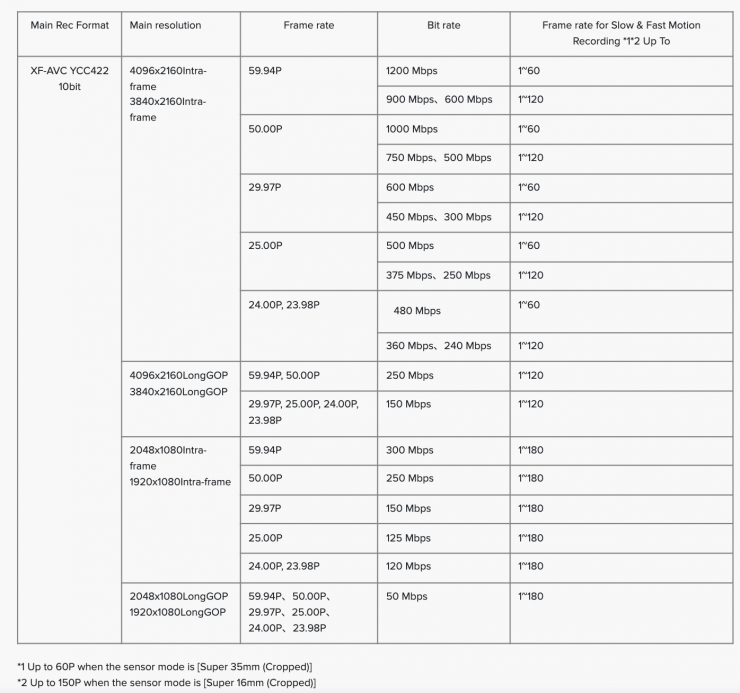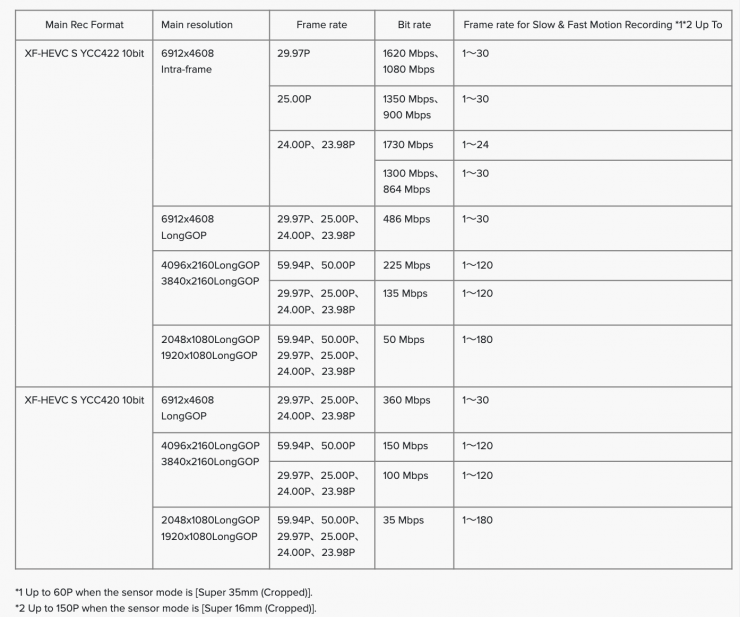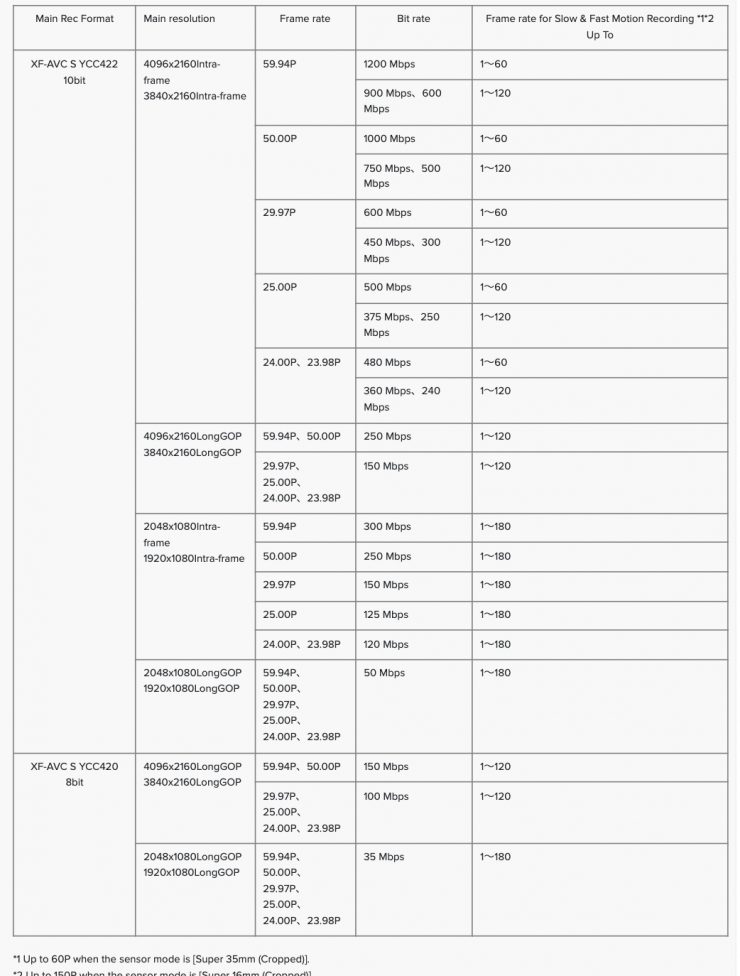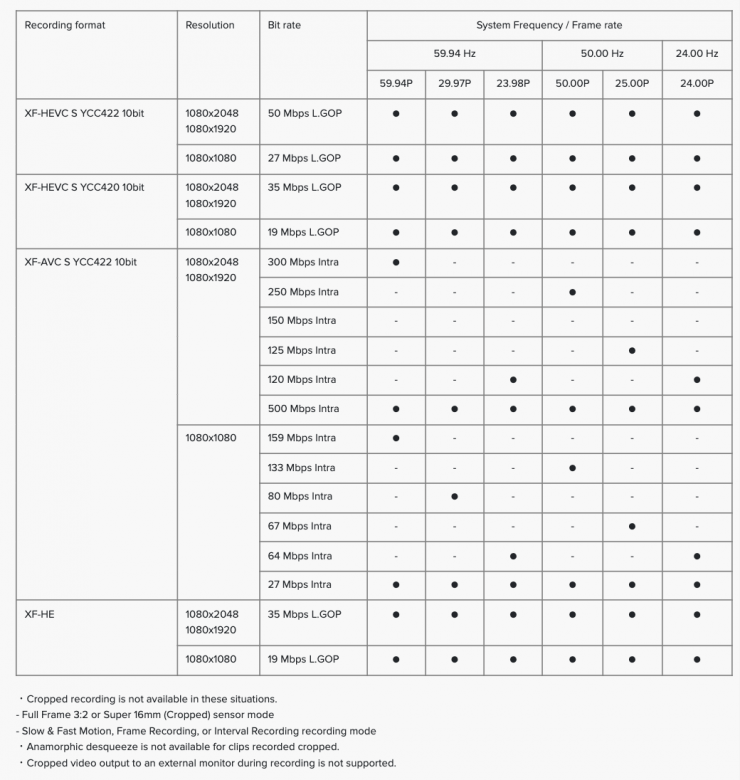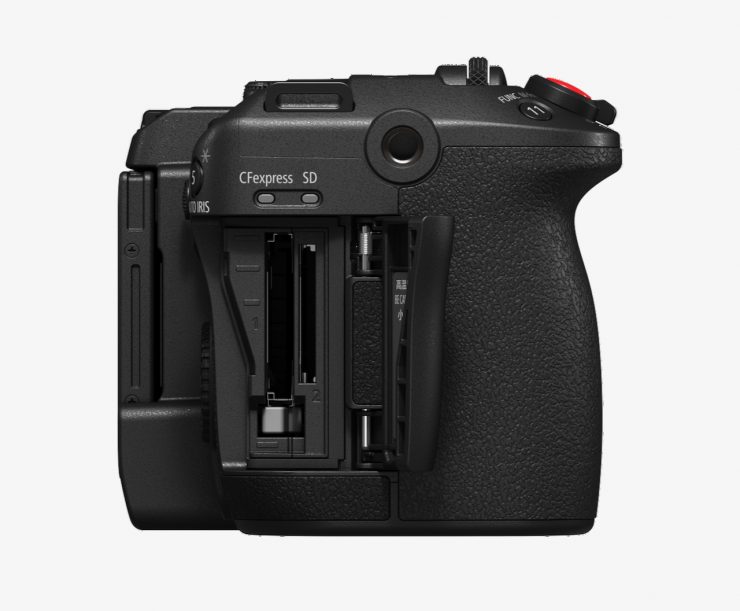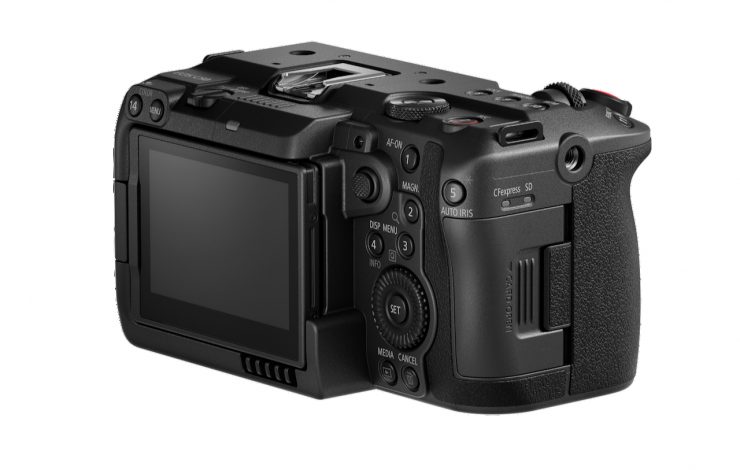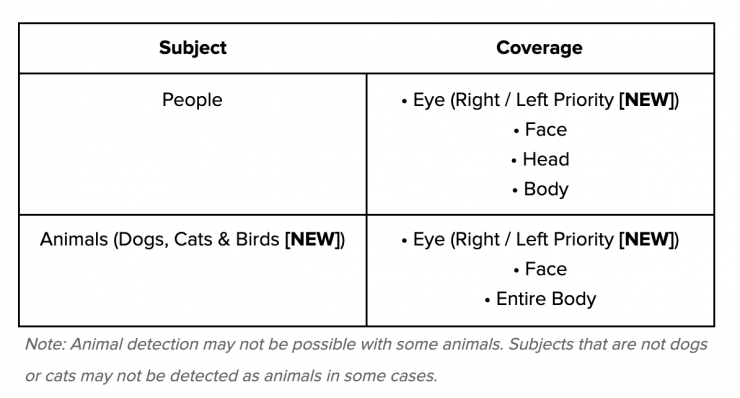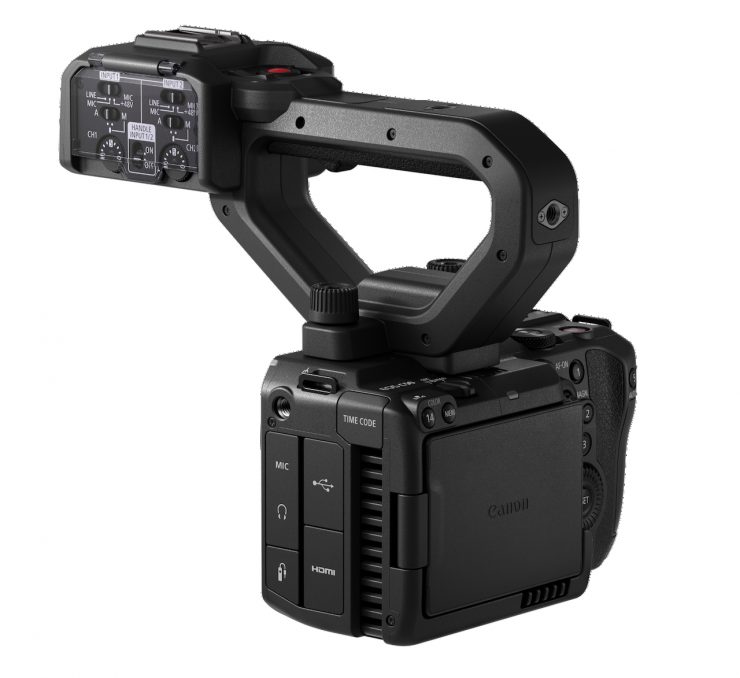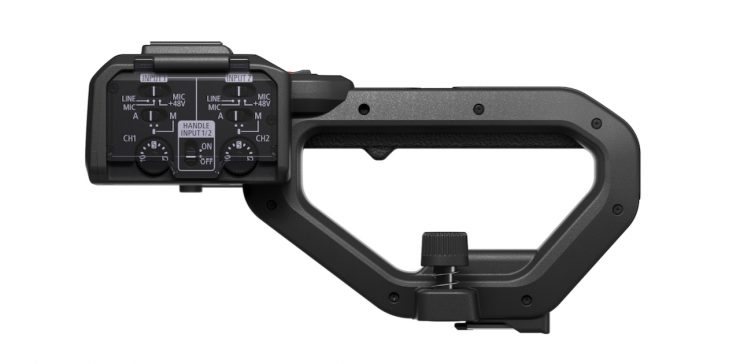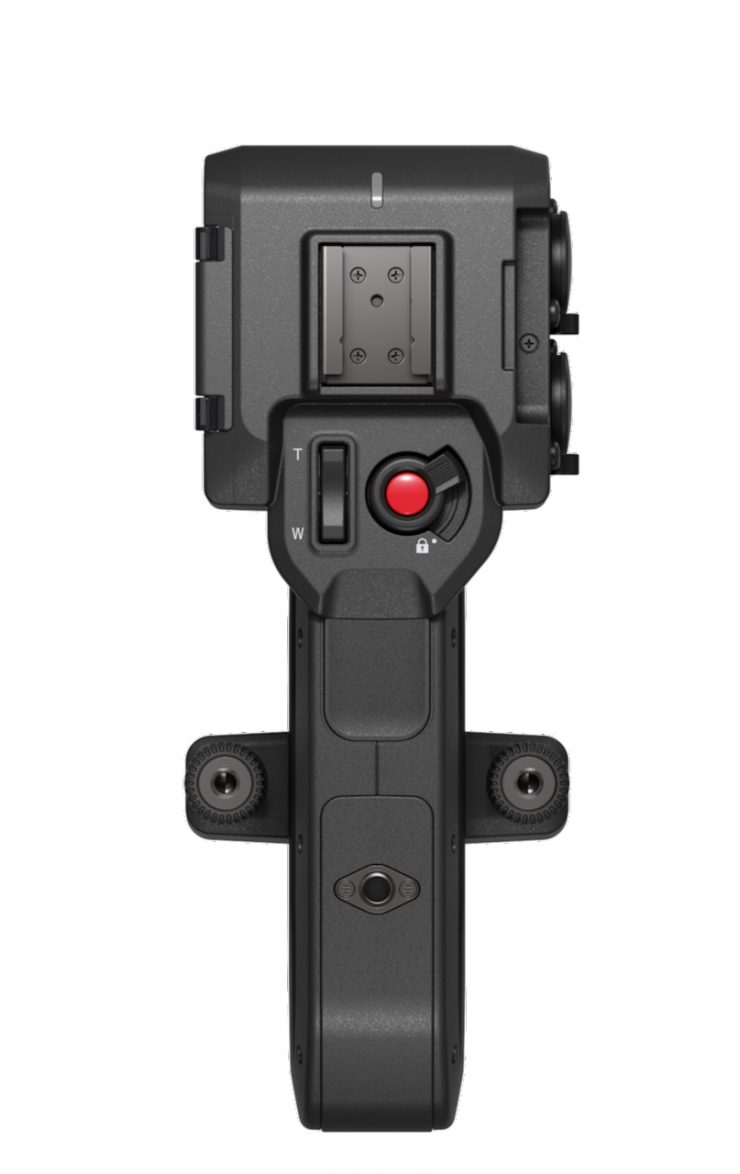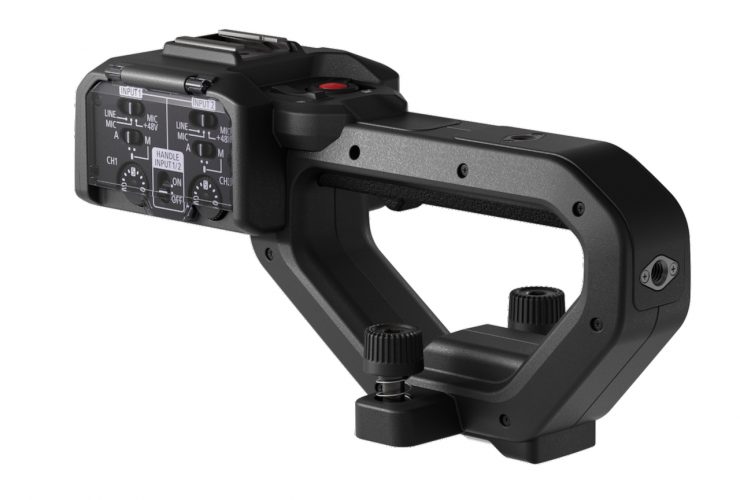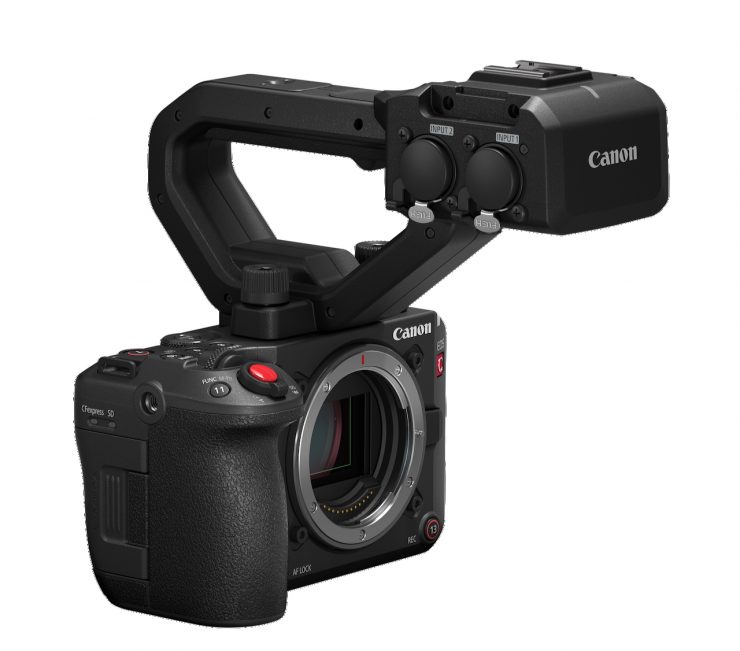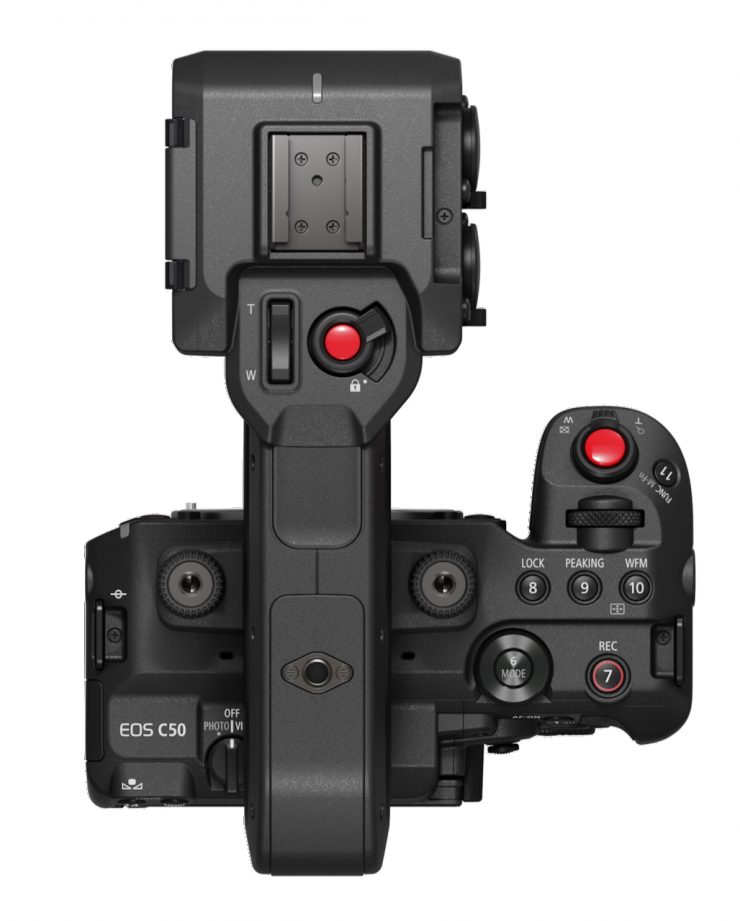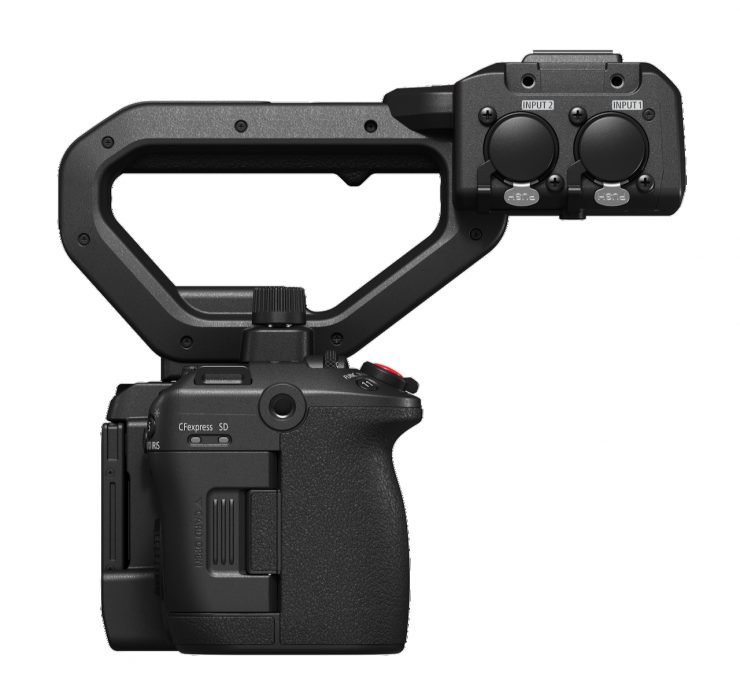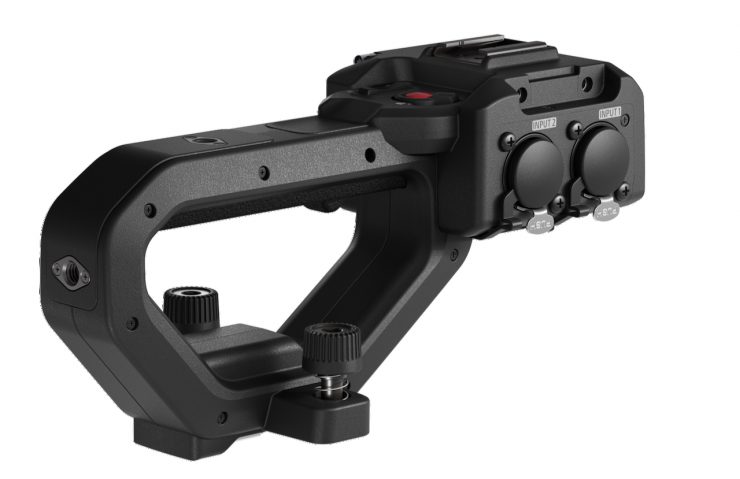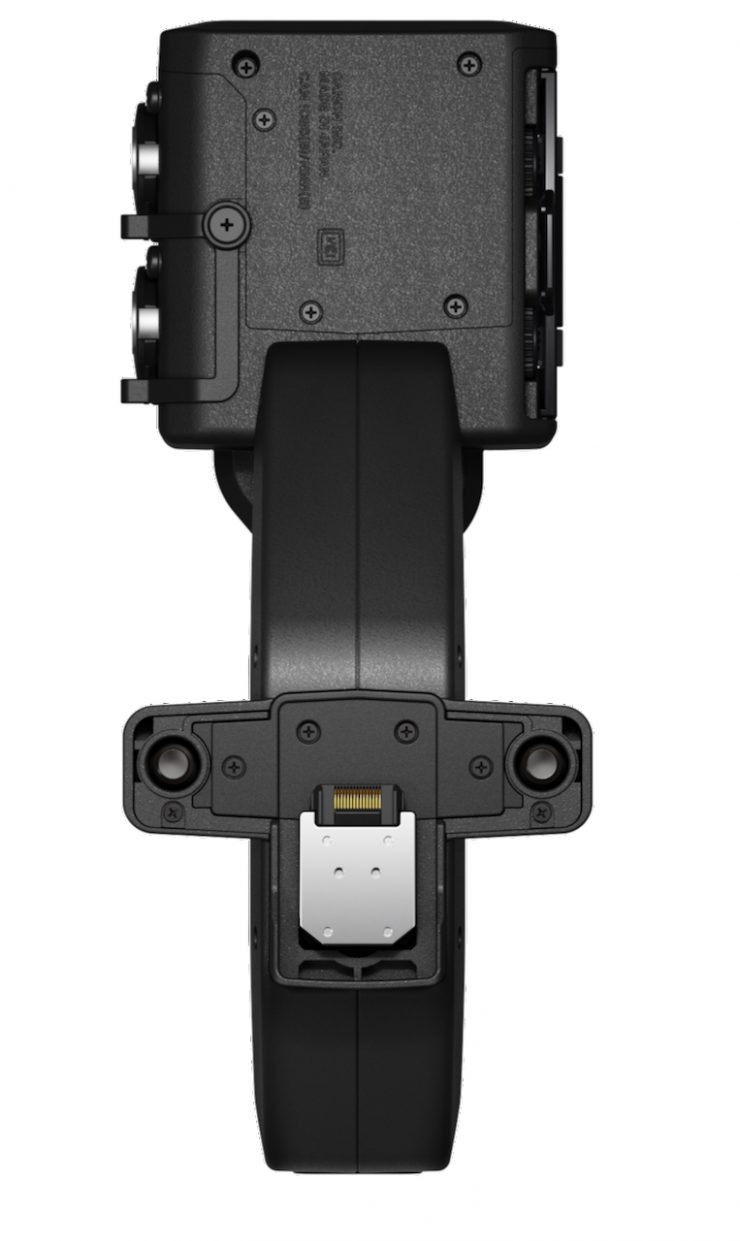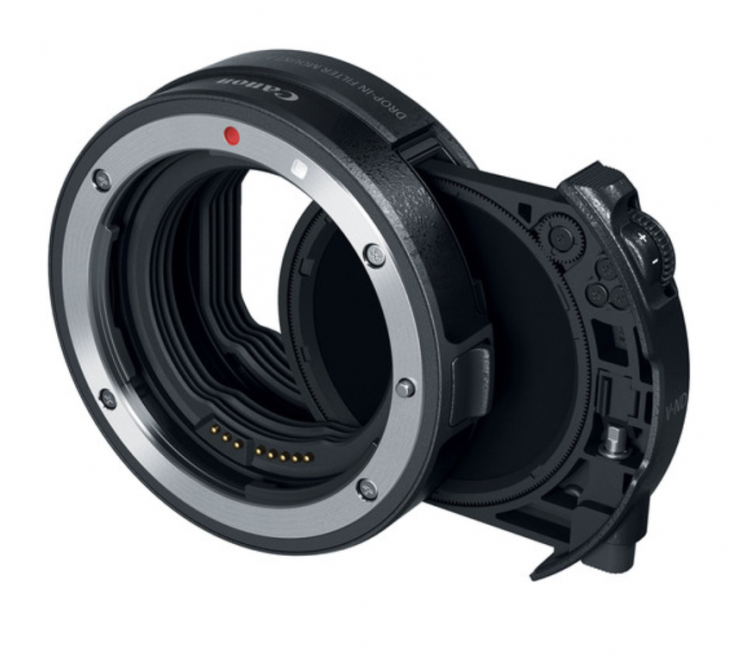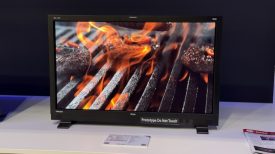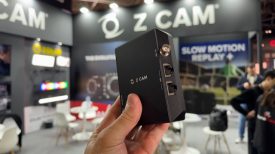Canon has announced the new EOS C50, which features 7K Open Gate Internal RAW recording at up to 30p, 4K at up to 120p, and 2K at up to 180p. It doesn’t have built-in ND filters, SDI, or an EVF.
Please note that some information may need to be changed, as prior briefings sometimes don’t have all of the correct information.
Key features
- High-resolution hybrid capability: 7K 60p internal RAW video recording, 32MP still photos
- 7K 60p Open Gate internal RAW video recording
- Advanced 7K full-frame CMOS sensor with open gate video recording
- 7K oversampling for higher resolution 4K movies
- 4K up to 120p
- 2K up to 180p
- Dual Base ISO support (ISO 800/64007), with up to 15+ stops of dynamic range
- Flexible range of professional recording formats, including 12-bit Cinema RAW Light, Canon Log 2, Canon Log 3 and XF-AVC S / XF-HEVC S
- Versatile, compact design with detachable handle unit and extensive rigging capability
- Native RF mount, compatible with mount adapter attachment for EF/PL lenses
- Two XLR audio inputs, Timecode terminal, HDMI OUT (Type-A), USB (Type-C), Multi-function shoe
- Dual slots for CFexpress Type B and SD cards, enabling simultaneous recording of different formats to each card
- Timecode
- Simultaneous Crop Recording
- Full-Sized HDMI
With the popularity of the compact Sony FX3 and FX30 cameras, it makes sense for Canon to enter the super-compact cinema camera market with an even more compact Cinema EOS camera. Their answer is the C50.
This is an excellent idea, as many Sony FX shooters have picked up the FX3 and FX30 as B-cams. That is exactly what we did at the station I work at, pair an FX3 with an FX6. If you’re short on cash, you could also easily use them as an A-cam with some added accessories.
Canon has stepped up over the last few years in making interesting cinema cameras. I have owned both the C70 and now the C80, and like them a lot due to the size and price. I do miss having an EVF as my old eyes struggle with shooting off a not-so-impressive on-board LCD screen. Yes, I purchased a high-bright 5″ monitor that is always used.
The next compact hybrid is the R5 C. I almost picked one up, but didn’t have the need for the stills feature since I already owned the R5.
We now have a dedicated compact C50 Cinema Camera that boasts impressive features in a small body. However, with such a compact form factor, there are always trade-offs.
Where does the C50 fit in Canon’s line-up?
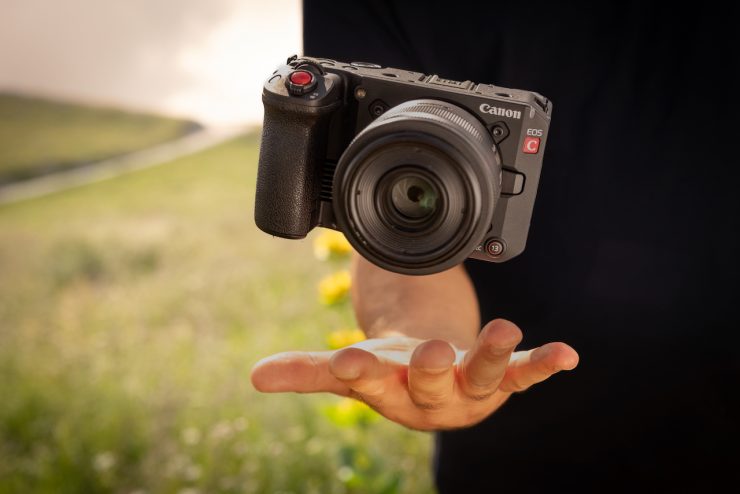
Canon unveiled the EOS C70 almost 5 years ago, and the EOS C80, 1 year ago to the day. Just like the C70, the C80 was designed to be a camera that bridged the gap between a traditional mirrorless hybrid and a digital cinema camera when it comes to form factor and features. Both those cameras were in direct competition with the Sony FX6.
Canon’s answer to the FX3 when it comes to a full-frame ‘video-centric’ camera, up until now, was arguably the R5 C. Early this year, Canon did release the PowerShot V1, but that is more of a competitor to the Sony ZV-1.
The FX3 has been a runaway success for Sony, and the Japanese company arguably offers the most complete range of anyone when it comes to affordably priced digital cinema cameras all the way up the high end.
Canon told me that the EOS C50 fits between the EOS R5 C and the C80. Just like Sony, Canon wants to fill out its line up with more offerings as it knows the majority of sales come at the more affordable end of the market.
The C50 keeps the form factor of a mirrorless hybrid with a lot of the features of a digital cinema camera. For those users who want a compact video camera without some of the bells and whistles of a larger digital cinema camera, the C50 may be the camera for you.
In the past, Canon tended to work on a 4-year cycle when releasing cameras, and that arguably hurt them. Timing often plays a critical role in the success or failure of a camera.
The content creator influencer boom
The compact camera market has seen a big resurgence recently, despite the fears that it would become a dwindling market with the advances in smartphone technology.
With this booming market, Canon (like everyone else) wants a slice of that pie. With content creators and influencers looking for a lightweight, video-centric camera at an affordable price, Canon needed to look into this market and come up with more solutions.
Open Gate
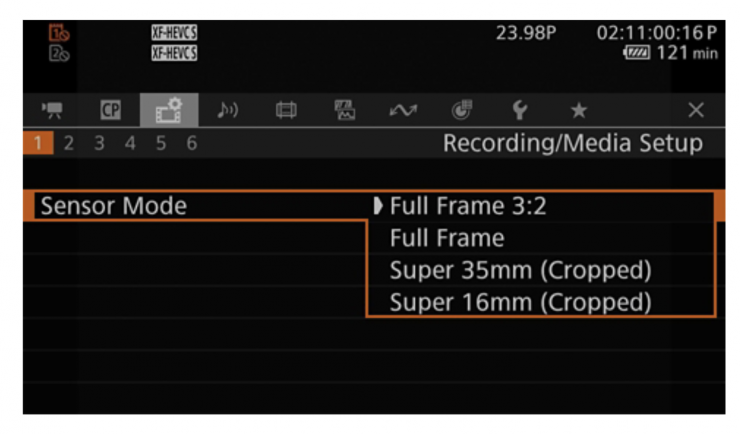
This is the first time we have seen Open Gate recording in any Canon camera. Even the flagship C700 didn’t offer Open Gate recording.
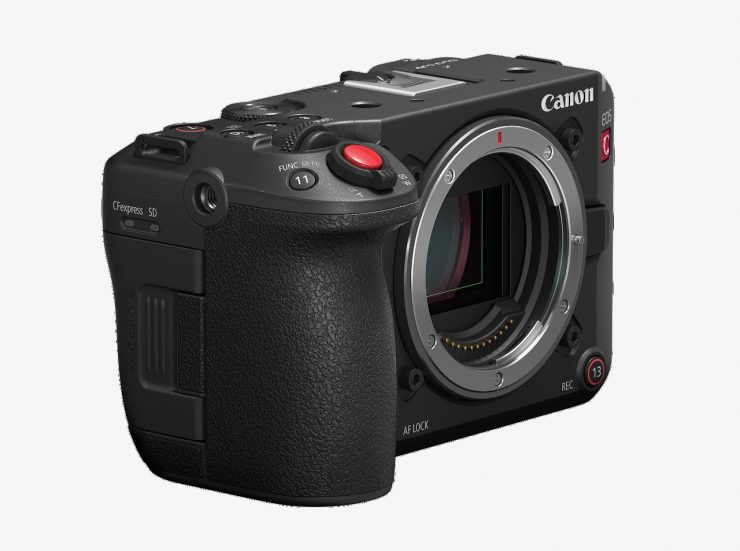
The ability to record in Open Gate on the C50 allows users to frame for 17:9, 16:9, and 9:16, etc. The high resolution also allows you to crop into your image for 4K and HD delivery.
Canon obviously felt the pressure from competing companies such as Panasonic, RED, and Blackmagic Design to offer Open Gate recording. Arguably, one of the biggest selling points of the Panasonic mirrorless hybrids, especially the recent ones, is that they offer Open Gate recording. As they don’t have any digital cinema cameras to protect, they don’t need to worry about segregating features.
For Canon, this does place them in a bit of a predicament, as they now need to offer Open Gate recording in some of their more expensive offerings, such as the C80 and C400 as not to upset the user base and to also make them more suitable to be used in conjunction with the EOS C50.
When I asked Canon about this, they told me that Open Gate recording will only be coming to the C400, and not the C80/ C70/ R5 C.
Body Design

Canon EOS C50 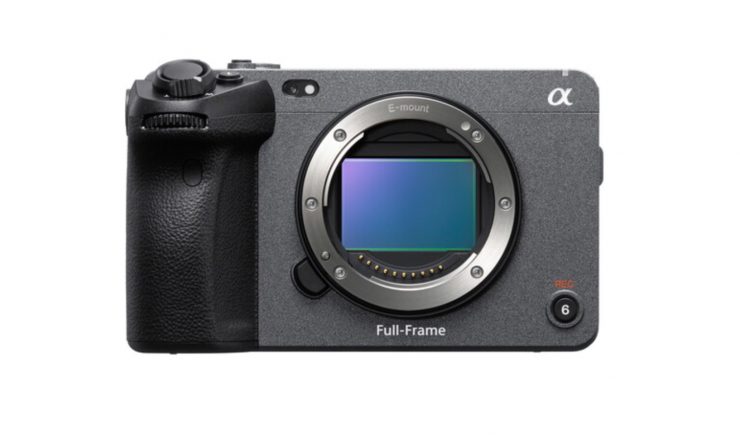
Sony FX3 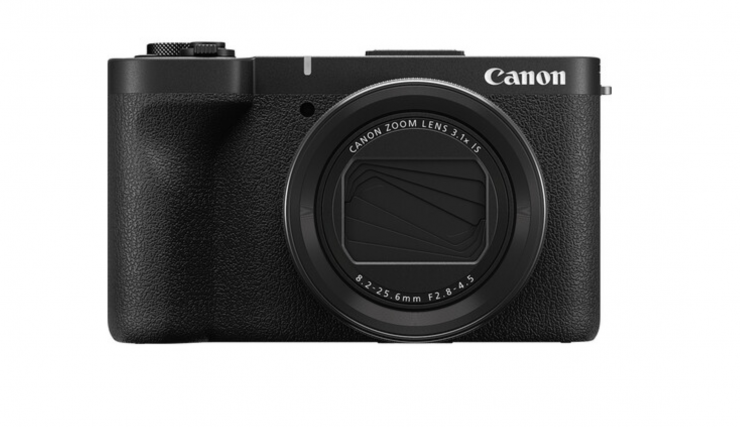
Canon PowerShot V1 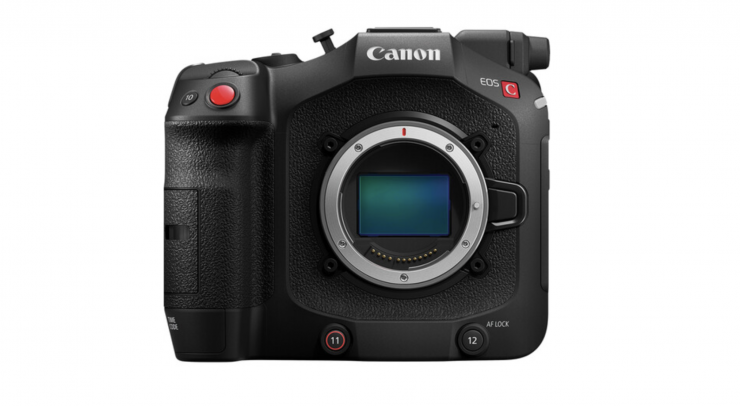
Canon EOS C80 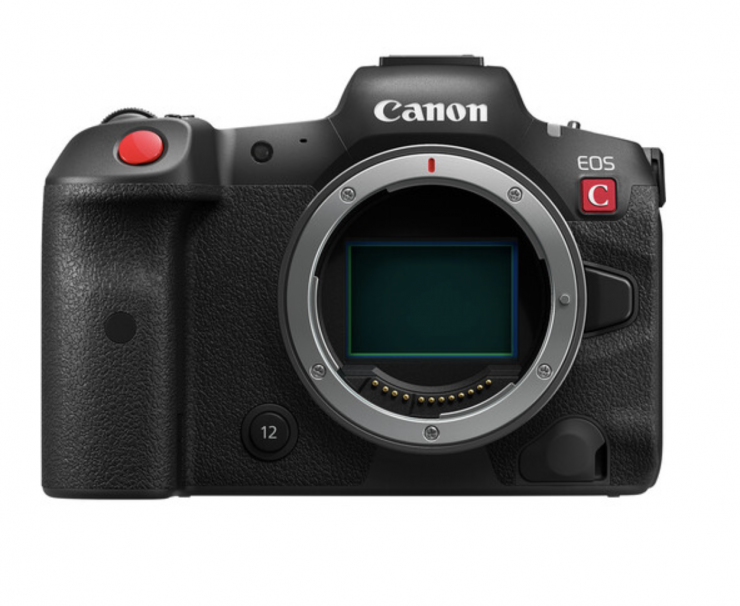
Canon EOS R5 C
Canon seems to have taken its design cues from the PowerShot V1 and the Sony FX3/FX2/FX30, but there are still some small aesthetic similarities that have been carried over from the C70, C80, and R5 C.
The control and button layout of the C50 isn’t a big departure from the C80 or the R5 C. Canon has tried to keep most controls in a similar position so users are familiar with the operation.
On the left-hand side of the camera, you will find a timecode jack, a USB-C port, 3.5mm mic jack, 3.5mm headphone jack, a full-sized HDMI output, and a remote control terminal.
There is no SDI port like you will find on the C80.
There are 13 function buttons on the body that can be individually mapped to perform different tasks.
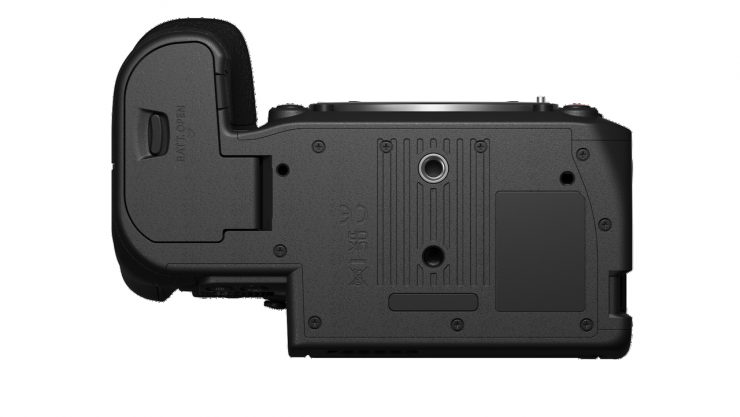
On the bottom of the camera, there is one 3/8″ and one 1/4-20″ mounting hole.
There is also an inbuilt microphone for catching scratch audio.
The C50 also features a special UI design for when you want to capture vertical video. Both the image and display overlays, as well as the menu system, can rotate to be shown correctly.
Size & weight
The Canon EOS C50 weighs 670g / 23.63 oz. and it is 84.5mm x 142mm x 9.5mm (H x W x D).
The C50 is lighter and smaller than the C70 and C80. It is roughly half the weight and size of the EOS C80.
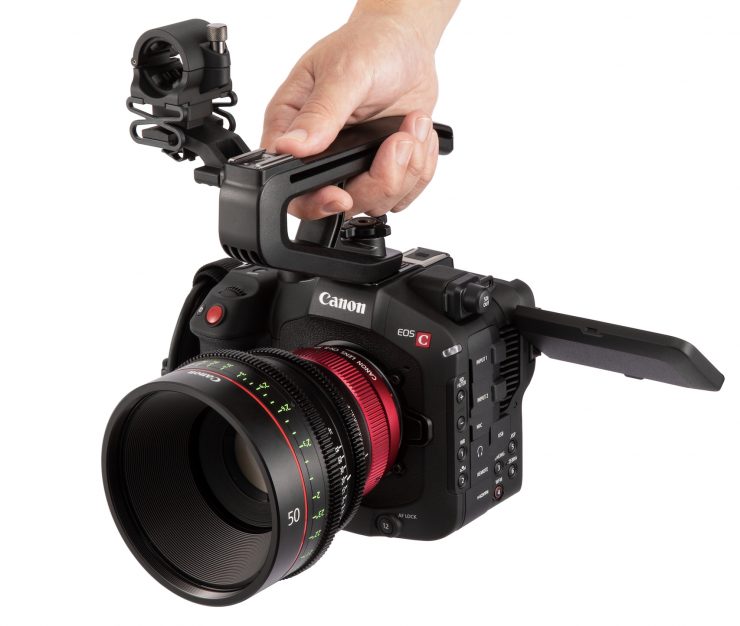
The C80 tips the scales at 1.3 kg (2.86 lb), and it has physical dimensions of (H) 137.4 mm / 5.41″ x (W) 160 mm / 6.3″ x (D) 115.9mm / 4.6″.
As another comparison, the C70 tips the scales at 1.17 kg (2.58 lb), and it has physical dimensions of (H) 130.2 mm / 5.1″ x (W) 160 mm / 6.3″ x (D) 115.9mm / 4.6″.
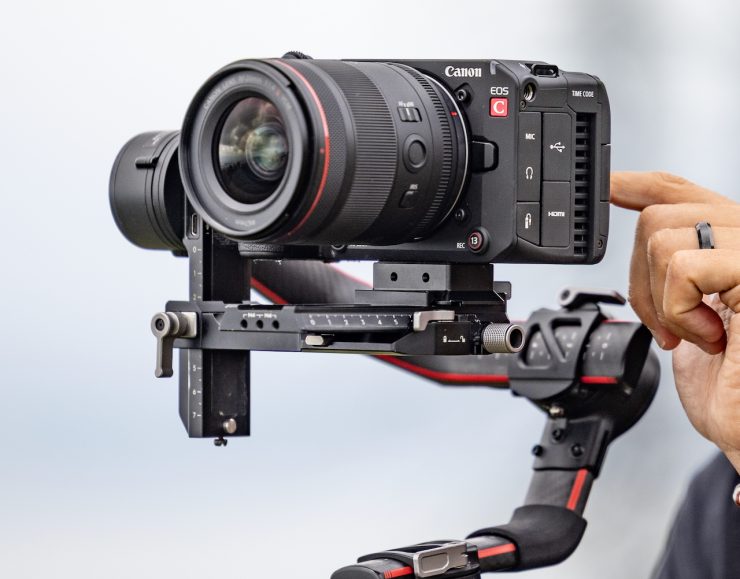
The compact size of the C50 makes it suitable for a variety of applications. Whether you are shooting handheld, putting the camera on a gimbal, or using a tripod, the C50 should work well.
So how does that weight compare to other Canon cameras, past & present? Below you can see:
| WEIGHT | |
| CANON C50 | 670g / 1.47 lb |
| CANON C80 | 1.3 kg / 2.86 lb |
| CANON C70 | 1.17 kg / 2.58 lb |
| CANON R5 II | 670 g / 1.5 lb (With Battery, Recording Media) |
| CANON R5 | 738 g / 1.62 lb (Body with Battery and Memory) |
| CANON R5 C | 770 g / 1.7 lb (With Battery, Recording Media) |
| CANON C400 | 1.5 kg / 3.4 lb (Body Only) |
| CANON C200 | 1.5 kg / 3.2 lb |
| CANON C100 Mark II | 1.5 kg / 3.2 lb |
| CANON C300 Mark III | 1.77 kg / 3.9 lb |
| Canon PowerShot V1 | 379g / 13.36 oz (Body Only) |
| Canon PowerShot G7 X Mark III | 304g / 1.19 lb (With Battery, Recording Media) |
| Canon XC15 | 910 g / 2 lb |
| CANON 1D C | 1.5 kg / 3.5 lb |
| CANON 1D X Mark III | 1.25 kg / 2.75 lb (Body Only) |
| CANON R1 | 920 g / 2.0 lb (Body Only) |
As you can see, the C50 is lighter than all of these other options.
So how does this price compare to some other mirrorless hybrids?
| WEIGHT | |
| Canon EOS R50 | 670g / 1.47 lb |
| Sony FX3A | 1.4 lb / 640g (Body Only) |
| Sony FX2 | 1.3 lb / 594g (Body Only) |
| Sony FX30 | 1.2 lb / 562g (Body Only) |
| Sony ZV-1 | 10.37 oz / 294g (With Battery, Recording Media) |
| Ricoh GR IV | 8.0 oz / 228g (Body Only) |
| Leica D-Lux 8 | 14.0 oz / 397g (With Battery) |
| Sony Cyber-shot DSC-RX100 VII | 10.65 oz / 302 g (Body Only) |
| Panasonic Lumix S9 | 0.9 lb / 403g (Body Only) |
| Panasonic Lumix S5 II | 1.45 lb / 658g (Body Only) |
| Panasonic Lumix S5 IIX | 1.45 lb / 658g (Body Only) |
| Panasonic Lumix GH7 | 1.6 lb / 721g (Body Only) |
| FUJIFILM X-M5 | 12.5 oz / 355g (Body Only) |
| FUJIFILM X-T5 | 16.8 oz / 476g (Body Only) |
| FUJIFILM X-T50 | 0.9 lb / 389g (Body Only) |
| FUJIFILM X-H2S | 1.3 lb / 579g (Body Only) |
| Nikon Z8 | 1.8 lb / 820g (Body Only) |
| Nikon Z6 III | 23.6 oz / 670g (Body Only) |
| Nikon Z50 II | 17.46 oz / 495g (Body Only) |
| Nikon Zfc | 13.8 oz / 390g (Body Only) |
| Nikon Z30 | 12.3 oz / 350g (Body Only) |
If we have a look at what is arguably the C50’s closest competitor, the Sony FX3A, as you can see, the cameras are fairly similar when it comes to weight.
| WEIGHT | |
| Canon EOS C50 | 670g / 1.47 lb |
| Sony FX3A | 640g / 1.4 lb (Body Only) |
Sensor
The EOS C50 utilizes a brand new 3:2 full-frame sensor. This sensor isn’t found in any of the existing Canon cameras.
Unlike the C80 that utilizes the exact same 6K full-frame Back Illuminated Stacked sensor as the C400, the EOS C50 features an entirely new sensor. This new sensor does not use a Dual Gain Output (DGO) like previous Cinema EOS cameras, nor a back-illuminated stacked CMOS sensor.
This is interesting because I would have expected the C50 to feature a Back Illuminated Stacked sensor like the C80 and C400. Canon also uses a back-illuminated stacked sensor in its R3.
One of the reasons a lot of companies are now utilizing back-illuminated stacked CMOS sensors is that they allow for better AF performance.

The camera also uses the DIGIC DV 7 processor, which is the same one that is found in the C80, C400, C500 Mark II, and C300 Mark III.
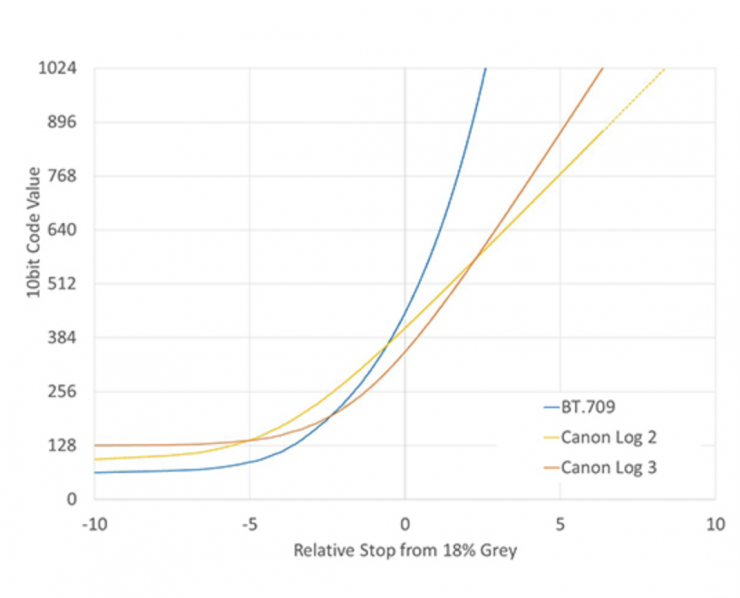
Canon claims that the C50 has 15+ stops when sensor mode is Full Frame, and 16 stops when sensor mode is Super 35mm (crop). Interestingly, the C50s claimed dynamic range when shooting in full frame is 1 stop less than the C80 and C400.

Just like with the C80, C400, and C500 Mark II, the C50 uses an oversampling process from the 7K image capture to produce 4K (DCI or UHD). Canon claims that this enhances image sharpness, curtails moire, and produces a lowered visibility of noise at the higher ISO settings. Canon states the image will be sharper with better detail and will resolve color better when shooting in 4K, 2K, and HD.
No DGO
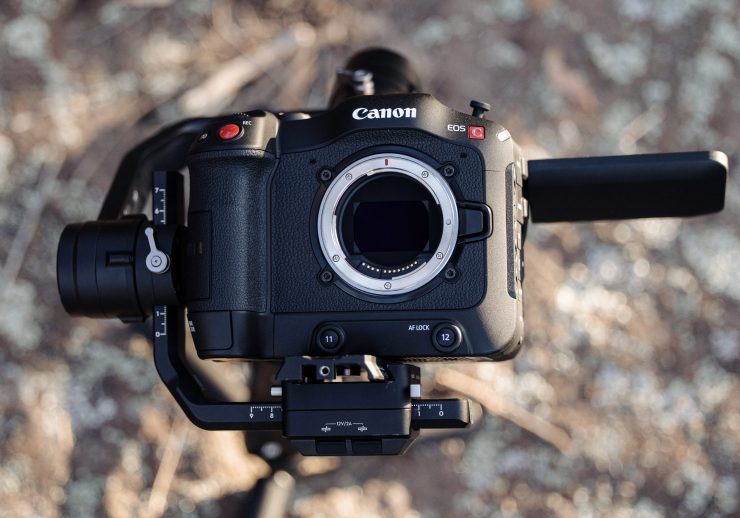
Unfortunately, it seems like Canon has ditched DGO sensor technology. I personally thought the sensor in the C70 was one of the best they had made.
With the DGO sensor in the C70, the construction of the red, green, and blue components entailed no algorithmic debayering processes. A parallel readout process within the image sensor separately extracts the four individual components, including the two spatially offset green components (green has twice as many spatial samples as the red and blue components). This approach avoids any of the reconstruction errors inevitably associated with algorithmic debayering.
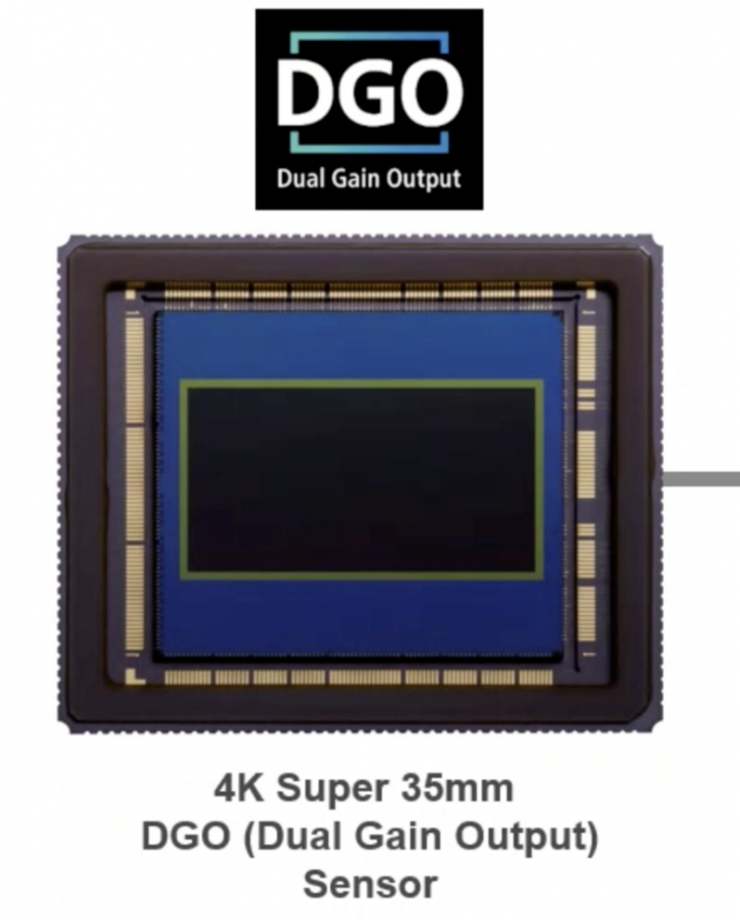
The DGO sensor produces images optimized for HDR by creating two images. One prioritizes highlights and the other prioritizes shadows and dark areas. Canon states that this sensor is capable of 16+ stops of dynamic range with reduced noise in the shadows and improved low light performance. You probably didn’t notice a massive increase in dynamic range if you are still finishing in SDR. It is with HDR that DGO was noticeable.
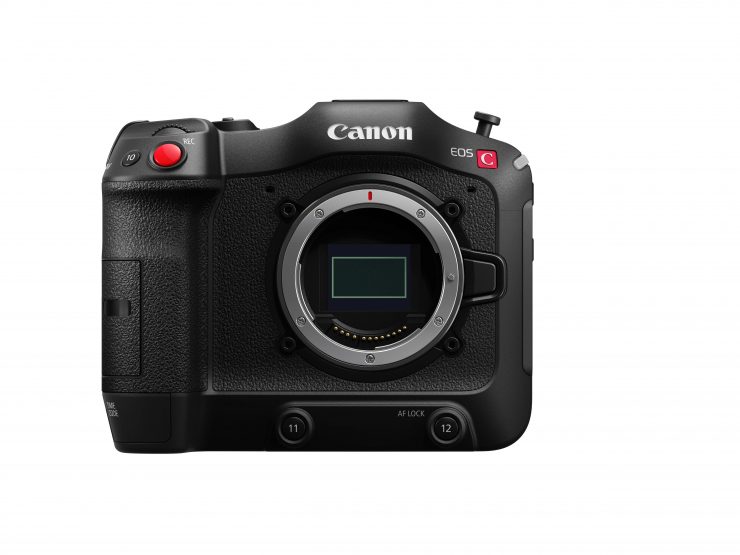
Noise was also greatly reduced because the Dual Gain Output signal was taken directly from the sensor and before any image processing took place.
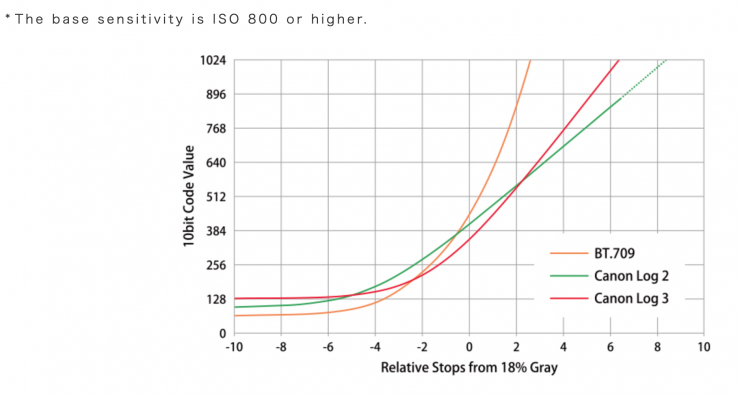
The DGO worked across all ISO ranges on the camera. Canon stated that the most dynamic range (16+ stops) was achieved when shooting at 800 ISO in Canon Log 2. If you shoot in Canon Log 3, then the dynamic range drops to 14 stops. If you moved off the camera’s native IS,O the DGO wasn’t as effective when shooting at higher ISO levels. It also appears that the extra dynamic range you are getting on the camera is coming below middle grey. If you look at images from the C300 Mark III, there didn’t seem to be any dynamic range improvement in the highlights if you compare it to the C500 Mark II, and the same was true with the C70.
There was a catch with this Dual gain Output system. It didn’t work when you were shooting in frame rates above 60p in S35 4K. However, it did work when you were shooting in 2K Super 16mm Crop mode up to 180fps. This was not surprising because the amount of processing power to deal with two readouts at high resolutions and high frame rates put a proportionally bigger load on the system.
You shouldn’t confuse Dual Gain Output with Dual Base ISO. Although it’s the same basic idea of having different readout calibrations, Dual Gain Output is much harder to do than Dual Gain ISO because that switches between the two. What ARRI and Canon are doing requires there to be a dual readout on every frame and then processing all of that on every frame.
The DGO also couldn’t be turned on or off.
Canon also included an Auto ISO option in the C70, which made it the first Cinema EOS camera to feature an Auto ISO capability. The Auto ISO could be set to either High or Low in the menu. For certain shooting applications, this was a nice feature to have, especially if you happen to be going from outdoors to indoors in one shot.
Dual Base ISO
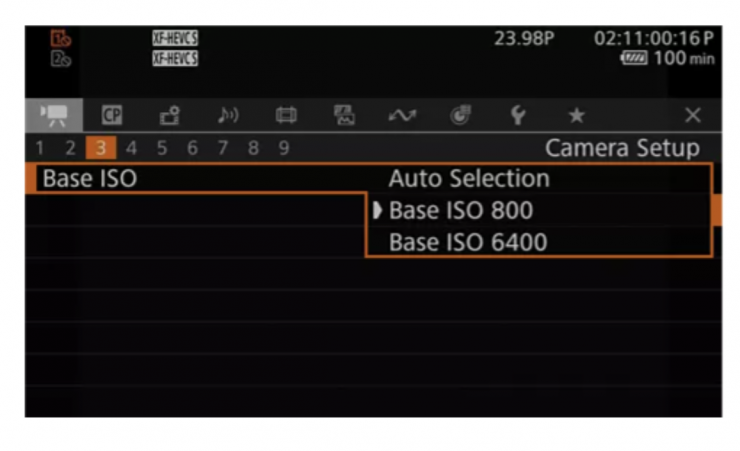
Unlike the C80, which features triple base ISOs, the C50 supports 2 base ISO levels (800 and 6400). The camera also features Auto Selection, which will switch from one of the two base ISO values to the other if it has a higher S/N ratio while maintaining the dynamic range accordingly.
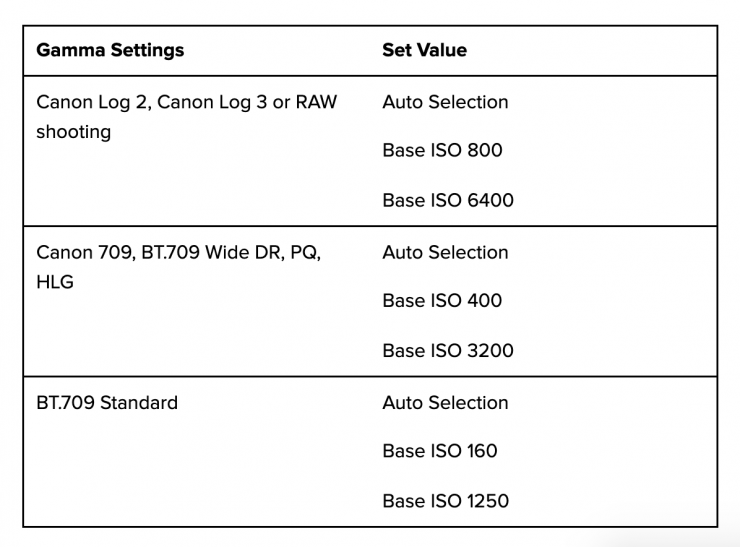
Above, you can see what the various dual base ISOs are when shooting in various modes.
Recording Capabilities

The C50 is capable of recording in resolutions up to 7K in Open Gate. It can also record in 4K DCI, UHD, 2K DCI, and HD.
The EOS C50 offers a variety of options in terms of onboard recording. You can record in Canon Cinema RAW Lite (with an additional three 12-bit Cinema RAW Light recording modes: HQ, ST, and LT.), XF-AVC, XF-HEVC S (H.265), or XF-AVC S (H.264).
The C50 can record 7K Open Gate (6960 x 4640 at 23.98/24.00/25/29.97 fps
at up to 30p in Canon RAW Lite and in XF-HEVC S (H.265) or XF-AVC S (H.264). It can also record up to 4K 120p in XF-AVC, XF-HEVC S (H.265), or XF-AVC S (H.264). Additionally, there is a 5K 5036 x 2656 (S35 crop) mode, as well, where you can shoot up to 60fps in Canon RAW Lite.
You can only shoot 7K Open Gate at up to 30p in Canon RAW Lite. The max resolution in XF-HEVC S (H.265) and XF-AVC S (H.264) is 4K.
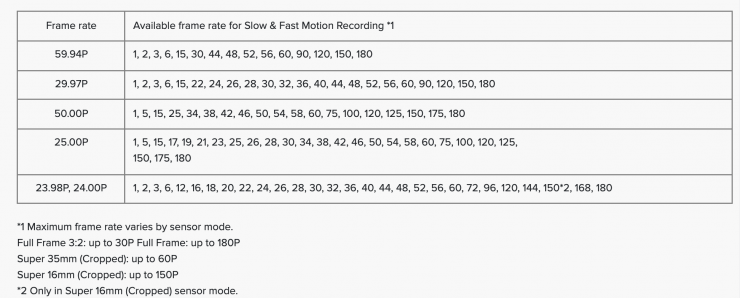
The camera can also shoot in 2K or HD at up to 180fps. In 2K 180p mode, there is a small crop as the angle of view becomes approx. 12% narrower.
When shooting 4K 120p, there is no crop.
On-Board Recording
- 7K Cinema RAW Light in Open Gate up to 30p
- 7K Open gate in XF-HEVC S (H.265), or XF-AVC S (H.264) at up to 60p
- 4K DCI or 4K UHD digital production formats with XF-AVC Intra
- 2K DCI or 1080-line HD digital production formats with XF-AVC Intra
| Cinema RAW Light 12-Bit | |
| 7K Open Gate (6960 x 4640) RAW ST, RAW LT | 23.98/24/25/29.97 |
| 7K (6960 x 3672) RAW HQ | 23.98/24/25/29.97 |
| 7K (6960 x 3672) RAW ST, RAW LT | 23.98/24/25/29.97/50/59.94 |
| Super35mm Crop (5036 x 2656) | 23.98/24/25/29.97/50/59.94 |
| Super 16mm (Crop) (2524 x 1332) RAW HQ, RAW ST, RAW LT | 23.98/24/25/29.97/50/59.94 |
During slow-motion recording, simultaneous recording may not be possible depending on the shooting frame rate.
| XF-AVC 4:2:2 10-Bit XF-AVC S 4:2:2 10-Bit XF-HEVC S 4:2:2 10-Bit | |
| 4K (4096 x 2160) | 23.98/24/25/29.97/50/59.94 S&F Mode: 61-120fps |
| UHD (3840 x 2160) | 23.98/24/25/29.97/50/59.94 S&F Mode: 61-120fps |
| 2K (2048×1080) | 23.98/24/25/29.97/50/59.94 S&F Mode: 113 – 180fps |
| HD (1920×1080) | 23.98/24/25/29.97/50/59.94 S&F Mode: 113 – 180fps |
Having Canon’s Cinema RAW Lite in the C50 is no real surprise. First introduced in the EOS C200 and then implemented into other Canon cameras, Cinema RAW Lite is a proprietary Canon RAW format. The good news is that most NLEs can read it with plugins.
Canon added three new Cinema RAW Light formats in a firmware update that came out for the C500 Mark II, and one of those options is in the C50, C80, and C400. This allows you to record in 12-bit at all frame rates. One of the advantages the C400 has over the C50 is that it can record in Cinema RAW Light LT, ST, and HQ formats, giving you the choice of four different RAW recording options, instead of just one.
While the file sizes and recording times may seem overwhelming to someone who isn’t used to shooting RAW, they are actually pretty small compared to most other digital cinema camera RAW formats. The original Cinema RAW Light files were about a 1/3 to 1/5 the size of Canon’s Cinema RAW format, which had to be recorded externally from the EOS C300 Mark II and EOS C700. The benefit of having these smaller RAW files is that they can be recorded internally to SD cards.
Canon’s Cinema RAW Light isn’t uncompressed, but the files still contain more than enough information to give you very clean images, good color accuracy, and a smaller chance of seeing any image artifacts. Unlike traditional RAW recording, Cinema RAW Light does not record in a frame-by-frame file structure. Instead, the RAW information is compiled into a single Canon RAW Movie file (.CRM).
The integrity of the RAW signal is protected by eliminating video processes like the Linear Matrix that selects the color gamut, and employing a special RAW OETF that optimizes the digital coding over the entire transfer curve for all ISO settings
When you are recording in RAW to the CFexpress cards, you can also record proxy files to an SD card.
Simultaneous Crop Recording
When you are recording 4K (DCI/UHD) to the CF Express Type B card, you can simultaneously do a sub recording in a cropped mode to the SD card. When shooting in simultaneous crop mode, the three format options include: 9:17, 9:16, or 1:1
Recording resolution combinations:
| MAIN | SUB | |
| VERTICAL CROPPED | 4096 x 2160 3840 x 2160 | 1080 x 2048 1080 x 1920 |
| SQUARE CROPPED | 4096 x 2160 3840 x 2160 | 1080×1080 1080×1080 |
Recording format combinations:
| MAIN | SUB |
| XF-AVC | XF-AVC S |
| XF-HEVC S | XF-HEVC S |
| XF-AVC S | XF-AVC S |
Below you can see what combination of gamma, color sampling, and bit depth is available in the various codecs.
H.264
| GAMMA | Color sampling | Bit Depth | Codec |
| Standard (SDR) | 4:2:0 | 8-bit | H.264 |
| Standard (SDR) | 4:2:2 | 10-bit | H.264 |
| Canon 709 | 4:2:0 | 8-bit | H.264 |
| Canon 709 | 4:2:2 | 10-bit | H.264 |
| BT 709 Standard | 4:2:0 | 8-bit | H.264 |
| BT 709 Standard | 4:2:2 | 10-bit | H.264 |
| HDR PQ | 4:2:0 | 8-bit | H.264 |
| HDR PQ | 4:2:2 | 10-bit | H.264 |
| Canon Log 2 Canon Log 3 | 4:2:0 | 8-bit | H.264 |
| Canon Log 2 Canon Log 3 | 4:2:2 | 10-bit | H.264 |
| PQ HLG | 4:2:0 | 8-bit | H.264 |
| PQ HLG | 4:2:2 | 10-bit | H.264 |
H.265
| GAMMA | Color sampling | Bit Depth | Codec |
| Standard (SDR) | 4:2:0 | 10-bit | H.265 |
| Standard (SDR) | 4:2:2 | 10-bit | H.265 |
| Canon 709 | 4:2:0 | 10-bit | H.265 |
| Canon 709 | 4:2:2 | 10-bit | H.265 |
| BT 709 Standard | 4:2:0 | 10-bit | H.265 |
| BT 709 Standard | 4:2:2 | 10-bit | H.265 |
| HDR PQ | 4:2:0 | 10-bit | H.265 |
| HDR PQ | 4:2:2 | 10-bit | H.265 |
| Canon Log 2 Canon Log 3 | 4:2:0 | 10-bit | H.265 |
| Canon Log 2 Canon Log 3 | 4:2:2 | 10-bit | H.265 |
| PQ HLG | 4:2:0 | 10-bit | H.265 |
| PQ HLG | 4:2:2 | 10-bit | H.265 |
Easy-to-manage folder structure

With XF-HEVC S / XF-AVC S, the folder structure has been changed from the conventional MP4 format, and video files can be saved in a folder with the same structure as Cinema RAW Light and XF-AVC. This means that the folder structure will be the same regardless of which video format is used, making video file management more efficient during shooting and editing.
Anamorphic De-Squeeze Options
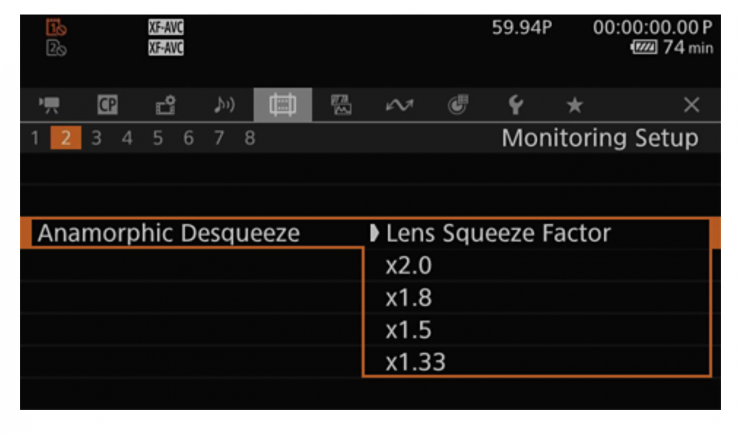
The anamorphic de-squeeze options in the EOS C50 are as follows:
- 1.3x
- 1.5x
- 1.8x
- 2.0x
Canon Log 3 / Cinema Gamut
To create some type of consistency with the Cinema EOS cameras, Canon has tried to standardize the GAMMA/COLOR SPACE settings across its range.
The EOS C50 has the ability to record in Canon Log 3 / Cinema Gamut and Canon Log 2, so it is easier to match and use alongside Cinema EOS cameras and the EOS R series.
What does it record to?
Unlike the C70 and C80, which both utilize dual SD card slots, the C50 has one CFexpress Type B card and one SD UHS-II card slot. The media card slots are located on the right-hand side of the camera, behind where you would grip it.
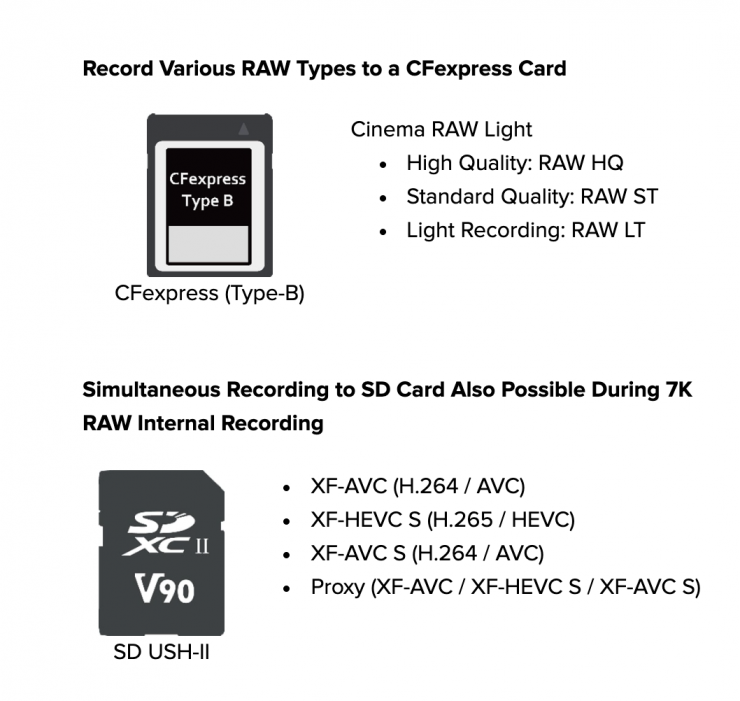
If you are going to record 7K Open Gate, then you need to use the CFexpress Type B card.
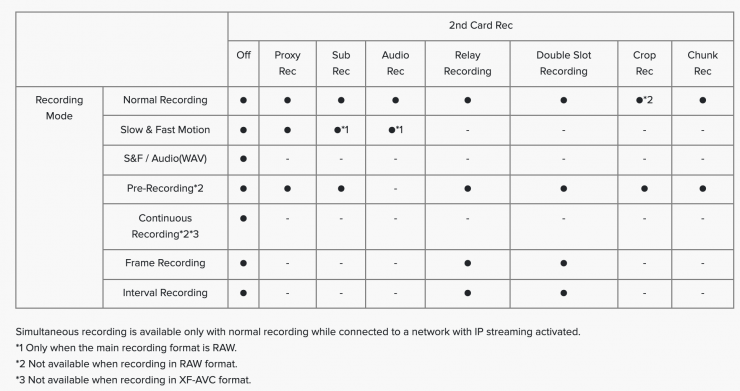
By having dual slots, the C50 can simultaneously record some of the same resolution and frame rates to two cards at once, or you can simultaneously record different formats at once, or you can do relay recording. As the camera can also record proxies, you could choose to record your main footage to one card and proxies to the other.
What can it output over HDMI?
The C50 can output up to 4K DCI 4:2:2 10-bit over HDMI.
| LCD MONITOR | HDMI OUT | |
| Peaking/ False Color/ Zebra/ Waveform/ B&W Image | Yes | Yes* |
| Anamorphic/ Magnification/ Marker | Yes | Yes |
| Color Bar | Yes | Yes |
| Test Tone/ Rec Command | No | Yes |
| Audio | No | Yes |
| Timecode | No | Yes |
| View Assist | Yes | Yes |
* Not displayed when [OSD Output: HDMI] is set to [Off (Clean)] or [Off] (however, B&W image display is possible).
No Built-In ND
This doesn’t come as any huge surprise, but the EOS C50 doesn’t feature any built-in ND. Just like the competing Sony FX3, you will have to use external ND filters. This is where the EOS C70 and C80 still have an edge.
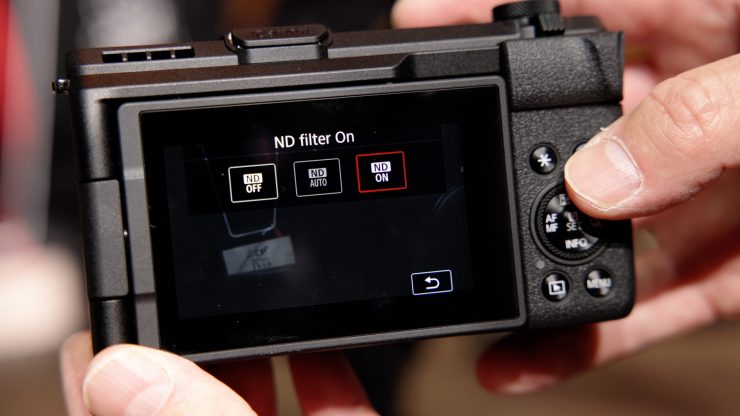
Putting ND into a small-sized full-frame camera is difficult. Canon’s lower entry PowerShot V1 features an in-built ND filter that allows you to add 3 stops (0.8 ND). However, 3 stops isn’t a lot, and it won’t be enough if you are shooting outdoors on a sunny day and want to adhere to the 180-degree shutter rule. You also can’t adjust the level of ND. It is only 3 stops. There is an Auto ND setting that will automatically add the 3 stops; however, that isn’t available when shooting in some modes.
Could Canon have put something similar into the EOS C50? Perhaps. Any ND is better than no ND. No company has yet to work out how to put built-in ND into a small-sized full-frame camera.
What about the heat?
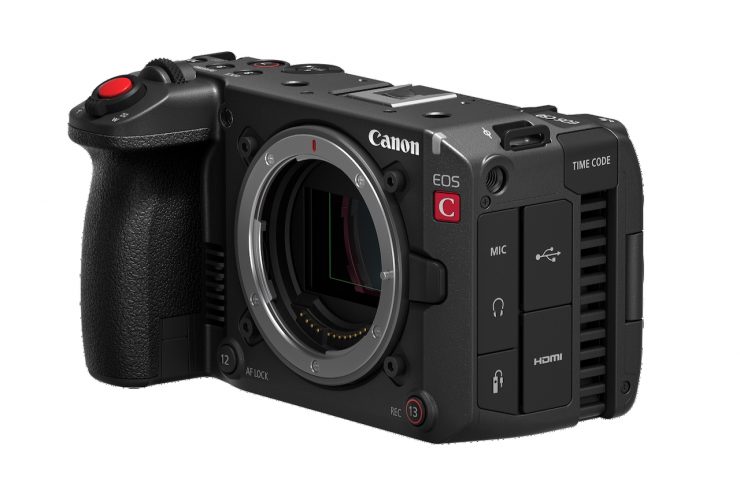
The Canon EOS C50 features an in-built fan. The heat generated inside the camera, including the processing engine and sensor, is dissipated using the fan, which enables continuous shooting for long periods of time, even at higher resolutions and frame rates.
According to Canon, the performance has been improved when compared to the R5 C. Canon has redesigned the camera’s internal airflow, and they have added an air intake to the front.
Canon claims that with this new design, the C50 can record for over 60 minutes continuously, even in 7K Open Gate at 60p in Canon RAW Lite.
Dual Pixel CMOS AF II
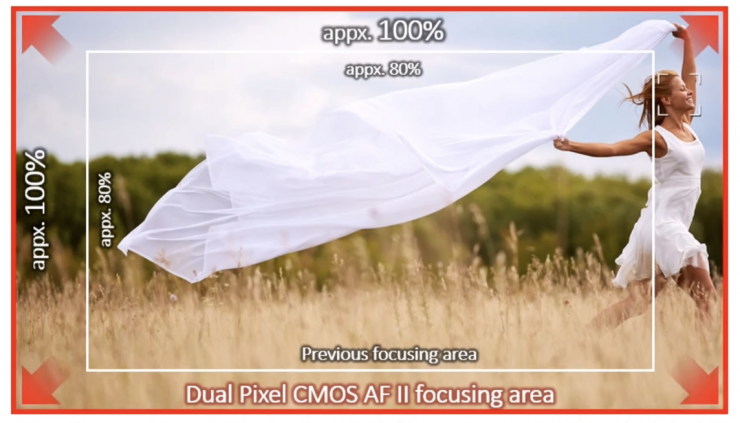
The EOS C50 utilizes the same Dual Pixel CMOS AF II (DAF) Technology that is found in cameras like the C80, R3, and C400.
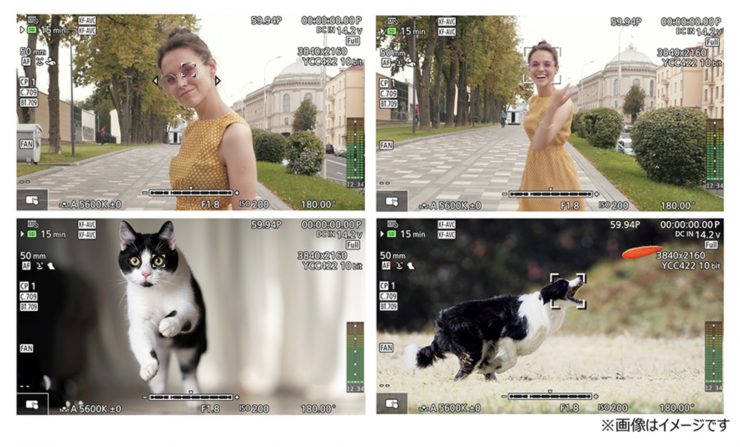
How does DPAF work? Two independent image signals can then be detected at each photosite. By implementing phase-difference AF, smooth focusing is accomplished with much higher speed and accuracy than was possible with previous technologies.
An improved Dual Pixel CMOS AF II system covers the entire sensor area for faster, more responsive, and more precise focusing performance. This upgraded phase-detection focusing system also has enhanced subject detection and tracking, with the ability to intelligently recognize eyes, faces, heads (including helmets), and animals, and tracking will automatically lock onto these subjects and maintain sharp focus.
To further fine-tune AF performance, the camera has the ability to set the AF tracking speed and response.
No IBIS
Just like the C70 and C80, the C50 doesn’t feature any IBIS. However, Electronic image stabilisation (Movie Digital IS) is available. When using Movie Digital IS the shooting range becomes narrower (cropped).
When an RF mount lens with its own lens-based optical image stabilizer is attached, this allows for effective blur reduction through coordinated control of the camera‘s electronic IS and the lens’s IS via RF mount communication.
Flip Out LCD Screen
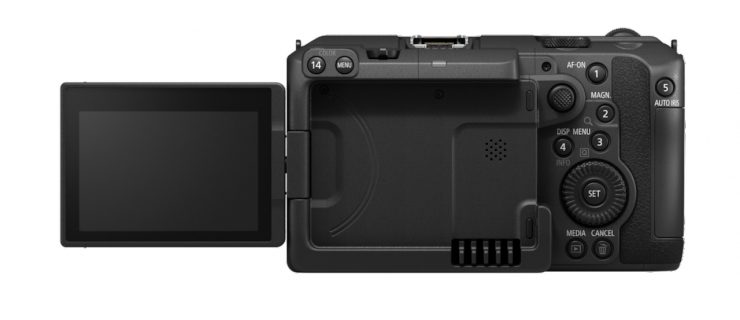
The EOS C50 doesn’t feature an EVF, so you will need to rely on the flip-out and fully rotatable Approx. 1.62 million dots (900xRGBx600) LCD screen.
I am not sure if this is brighter than previous versions found on cameras like the C70 and C80.
New Top Handle & Multi-shoe Interface
With the C50, you get a newly designed top handle, and Canon has also included the Multi-Shoe Interface on the camera body.
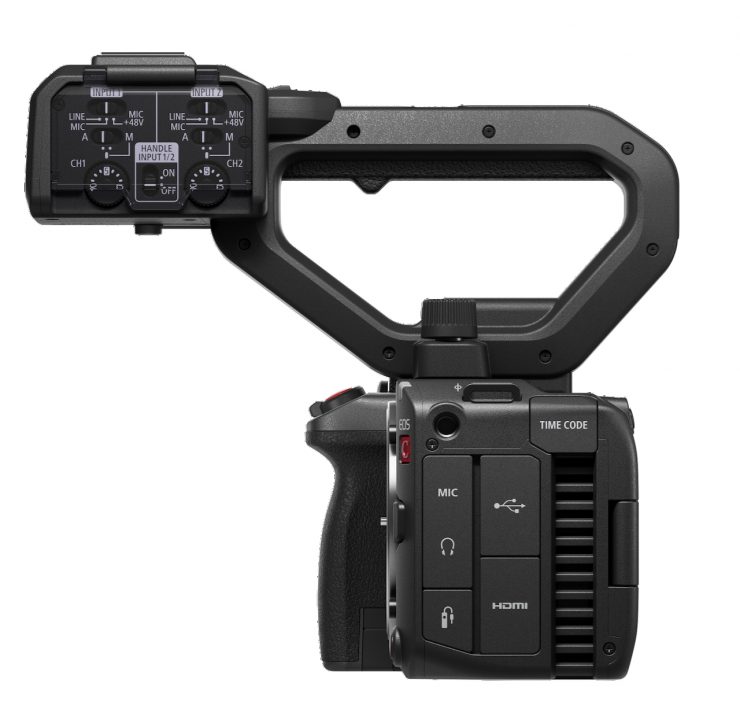
EOS C50 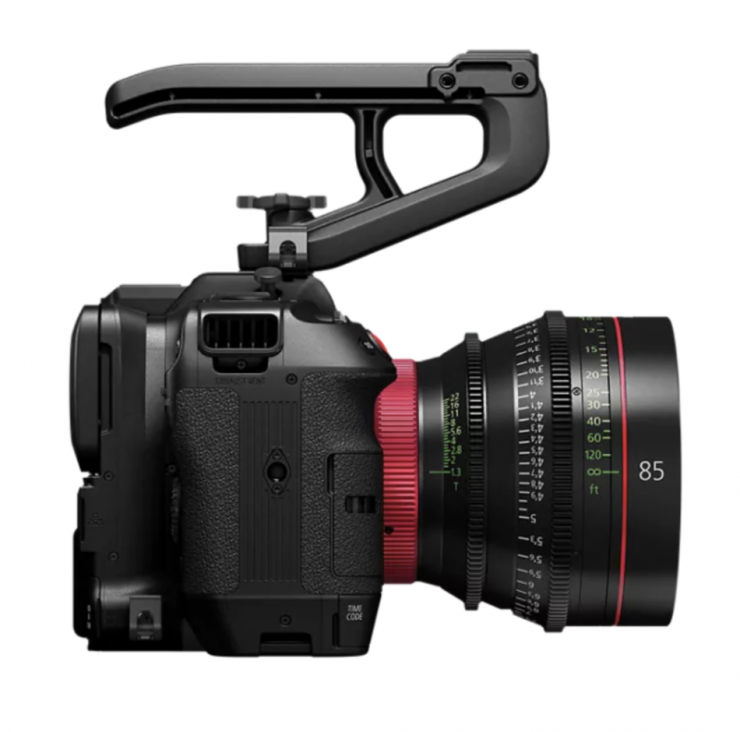
EOC C80
The handle attaches to the Multi-shoe Interface. Unlike the C80 handle, this handle integrates an audio module with two XLR inputs, a start-stop button, and a zoom rocker.
The Multi-shoe Interface passes power through to the handle, and the audio signals are also routed directly to the camera without the need for additional cables.
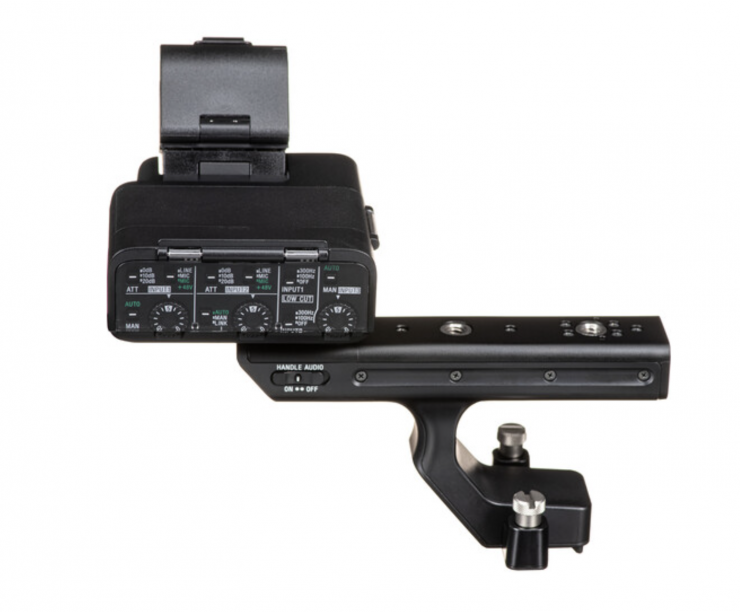
This is very similar to the Sony XLR-H1 XLR Handle Unit solution for the Sony FX3, FX2, and FX30.
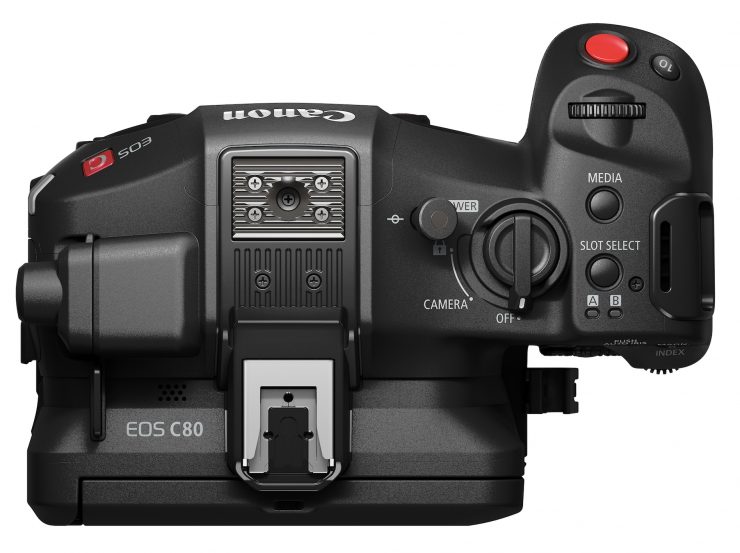
This is different from the EOS C80, where the handle attaches to the front top part of the camera, while the Multi-shoe Interface is located further back. This allows you to use both at the same time.
Photo Capabilities
The C50 is capable of taking 32MP still images. It also has a 40 FPS burst mode for high-speed continuous shooting, a maximum ISO setting of 64000, and it can do pre-continuous shooting at up to 20 shots.
These capabilities make it a pretty good option for anyone who is doing multimedia and wants to capture both stills and video. While the capabilities aren’t going to be as good as the R5 C, they are still going to suit a lot of people’s requirements.
RF Mount
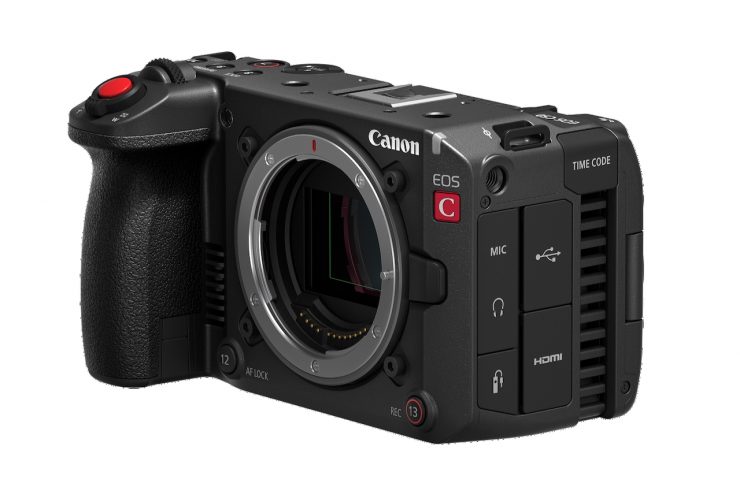
The C70 was Canon’s first dedicated video camera to utilize the RF mount, and the C50, just like the C80, follows suit. The RF mount is a lot more versatile than the EF mount, and it allows users to use a variety of different lenses through the use of adapters. The EF mount was designed in the ’90s, and it technically reached its limits, and that’s why Canon moved in a different direction.
Canon PL-RF Adapter

Canon has its own proprietary PL-RF Adapter that will work with the C80 and C400. This should also work
It can be user-installed on the camera using four M3 bolts and locking plates that attach to the front of the camera.
The adapter, unlike other third-party solutions on the market, has electronic connections, and it can utilize the Cooke /i protocol to send compatible lens information to the camera. This metadata is also useful when working in virtual production environments.
A lot of potential users of the C50 who still own EF glass are likely to use Canon’s EF-EOS R Drop-in filter lens adapter. You could also use products like the MOFAGE POCO Drop-In Filter Lens Mount Adapter Kit (Canon RF to PL) if you are running PL glass.
Connectivity

The EOS C50 camera supports the XC protocol, which allows for remote control over IP via Wi-Fi or a compatible third-party USB-C Ethernet adapter. The EOS C50 camera is also compatible with the Multi Camera Control App and features native integration of frame.io camera to cloud.
Price & Availability
The Canon EOS C50 will retail for $3,899 USD, and it will be available in early November.
So how does this price compare to some other mirrorless hybrids?
| PRICE | |
| Canon EOS C50 | $3,899 USD |
| Canon EOS C80 | $5,849 USD |
| Canon EOS C70 | $4,399 USD |
| Canon EOS R5 C | $3,399 USD |
| Canon EOS R50 V | $699 USD |
| Canon PowerShot V1 | $979 USD |
| Canon PowerShot G7 X Mark III | $849 USD |
| Blackmagic Design PYXIS 6K Cinema Box Camera (Leica L) | $2,495 USD |
| Sony FX3A | $4,098 USD |
| Sony FX2 | $2,698 USD |
| Sony FX30 | $1,748 USD |
| Sony ZV-1 | $698 USD |
| Ricoh GR IV | $1,496.95 USD |
| Leica D-Lux 8 | $1,915 USD |
| Sony Cyber-shot DSC-RX100 VII | $1,698 USD |
| Panasonic Lumix S9 | $1,197.99 USD |
| Panasonic Lumix S5 II | $1,647.99 USD |
| Panasonic Lumix S5 IIX | $1,997.99 USD |
| Panasonic Lumix GH7 | $1,997.99 USD |
| FUJIFILM X-M5 | $899 USD |
| FUJIFILM X-T5 | $1,995.95 USD |
| FUJIFILM X-T50 | $1,599 USD |
| FUJIFILM X-H2S | $2,899.95 USD |
| Nikon Z8 | $4,296.95 USD |
| Nikon Z6 III | $2,696.95 USD |
| Nikon Z50 II | $1,006.95 USD |
| Nikon Zfc | $1,196.95 USD |
| Nikon Z30 | $806.95 USD |
What are your thoughts on the new EOS C50? Let us know in the comments section below.
